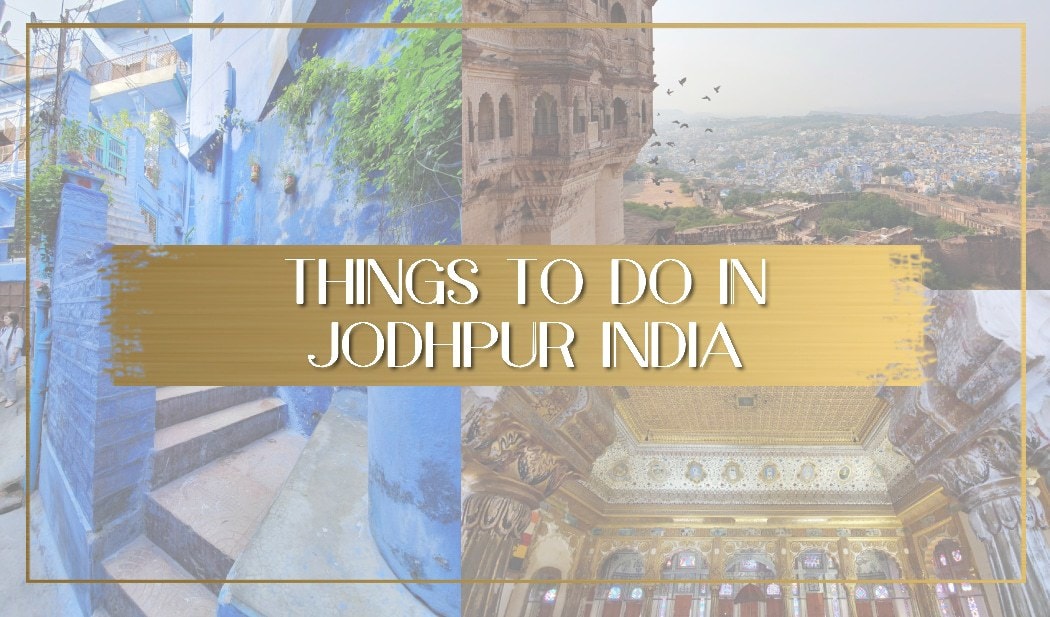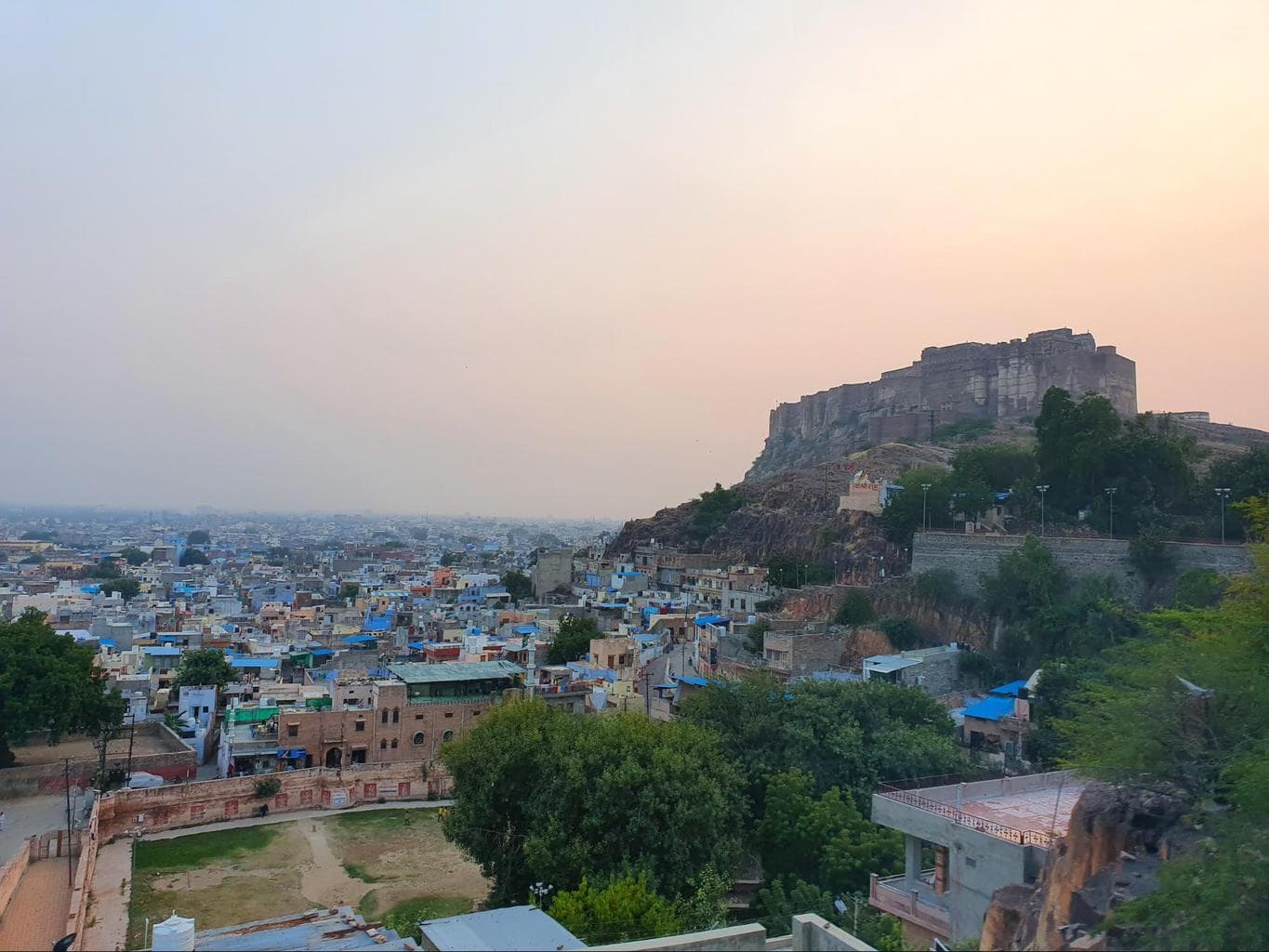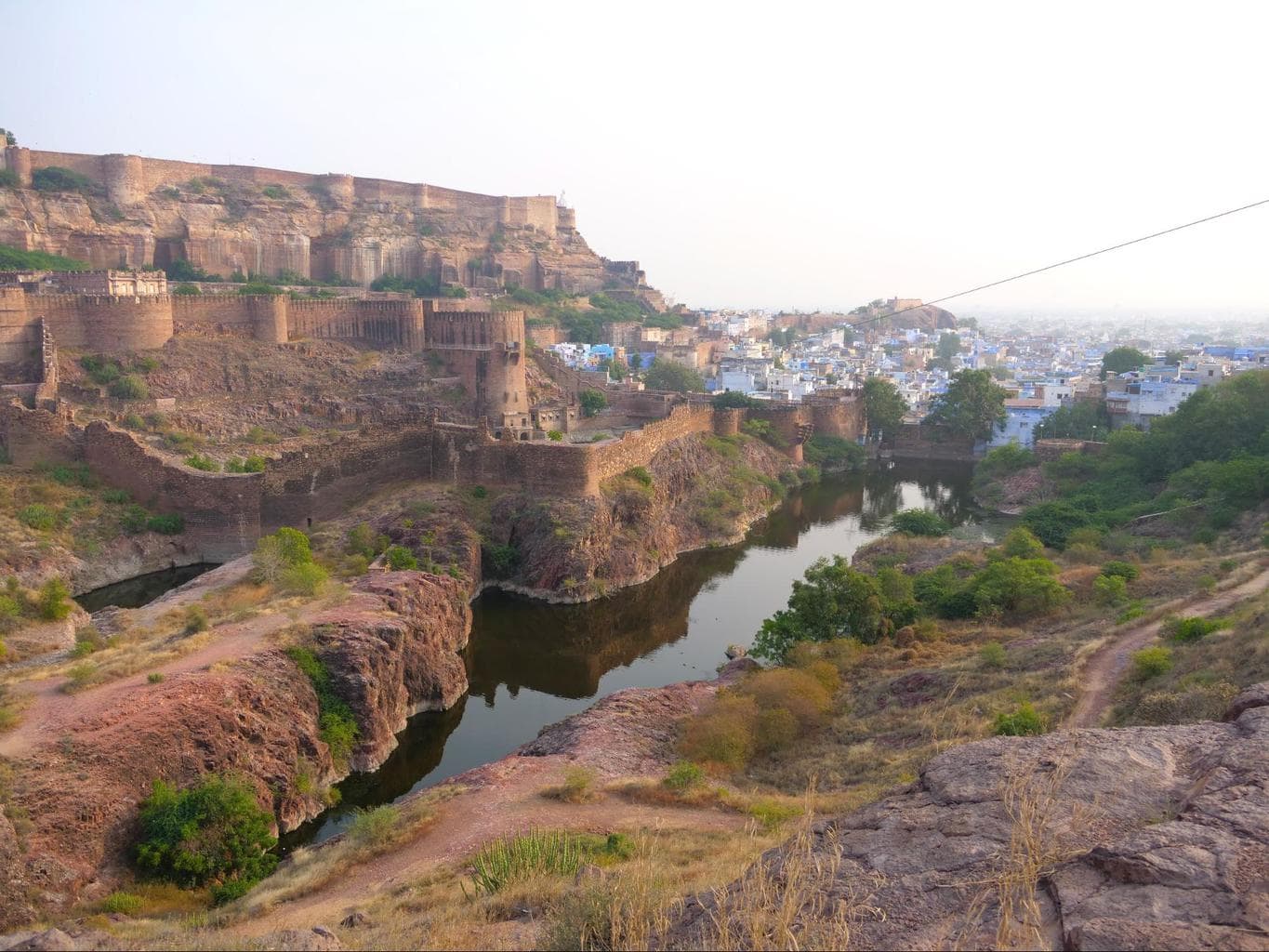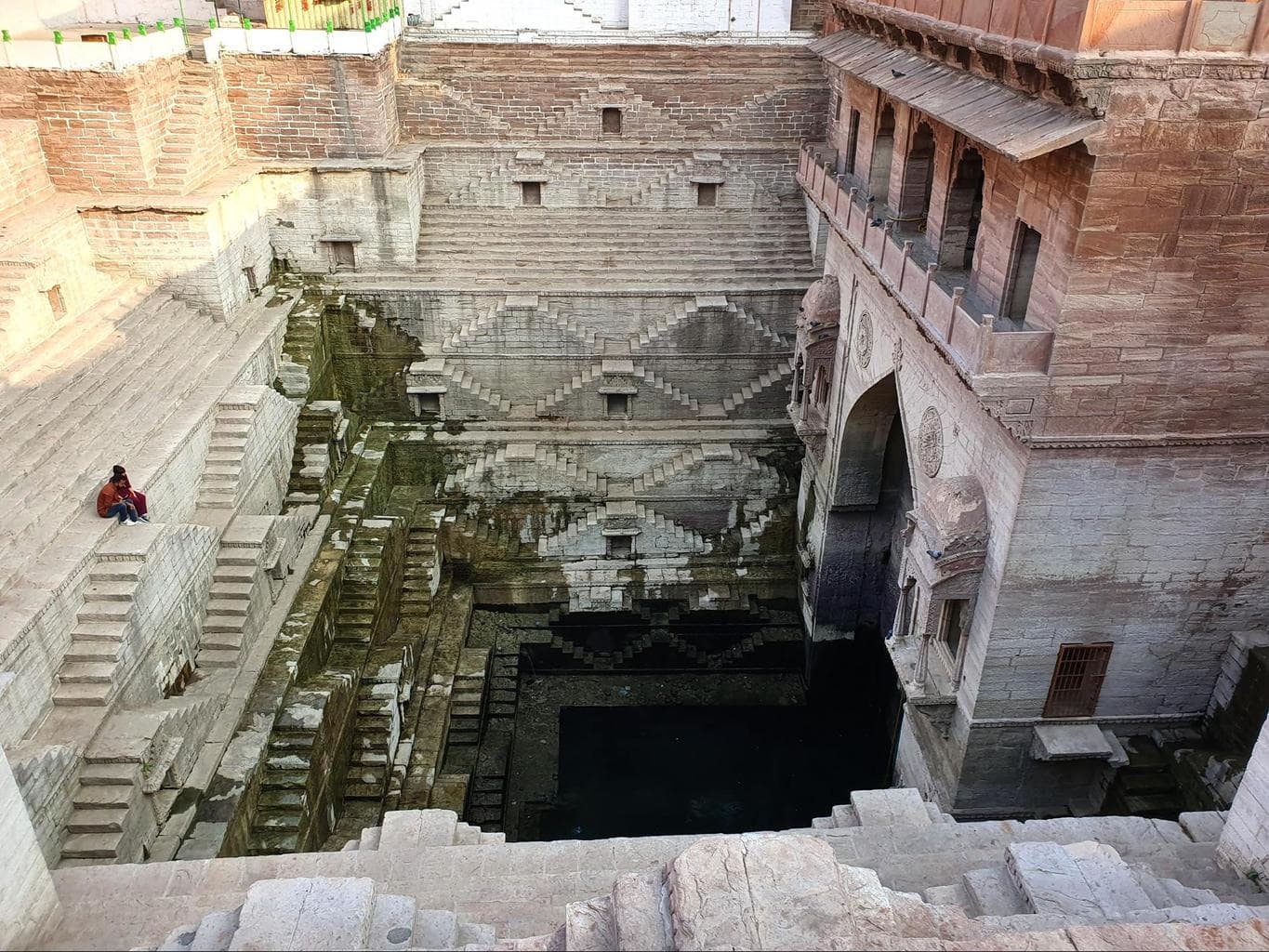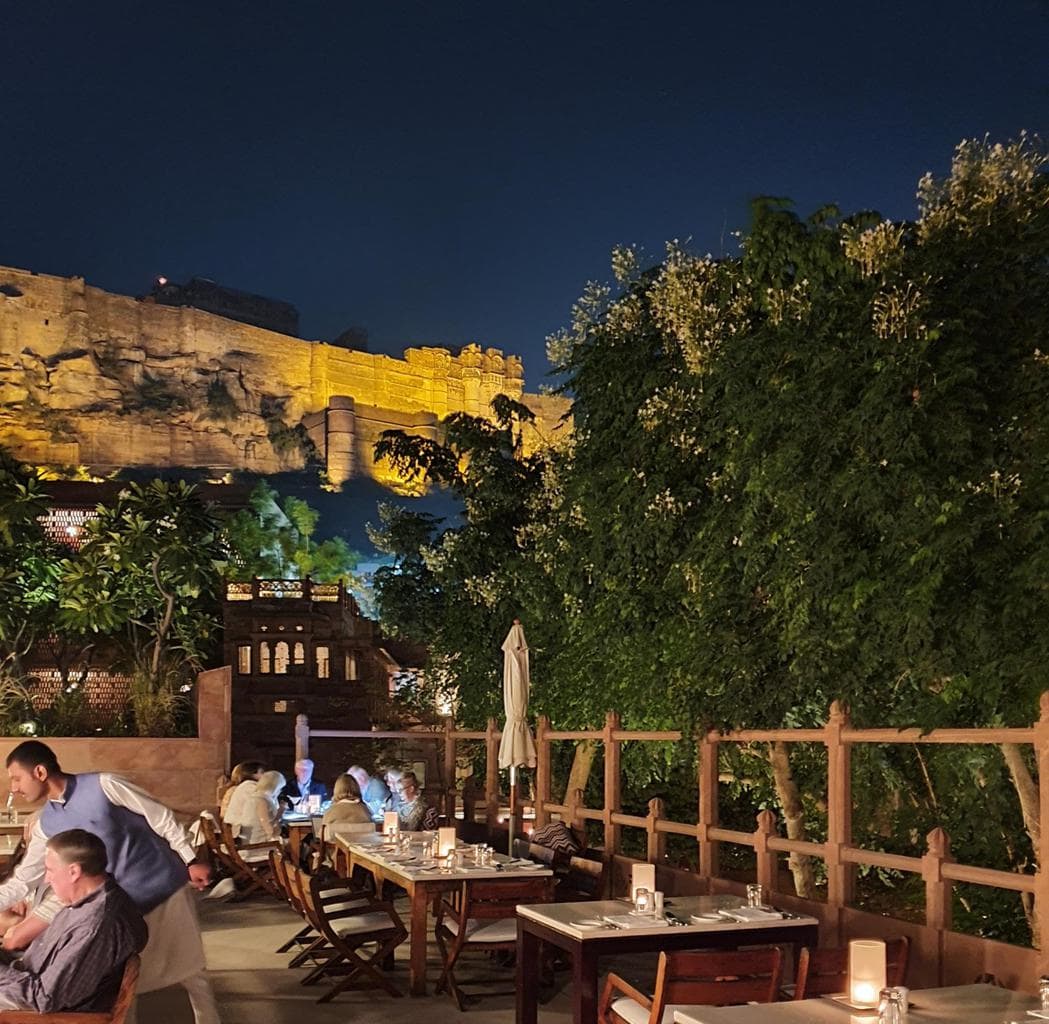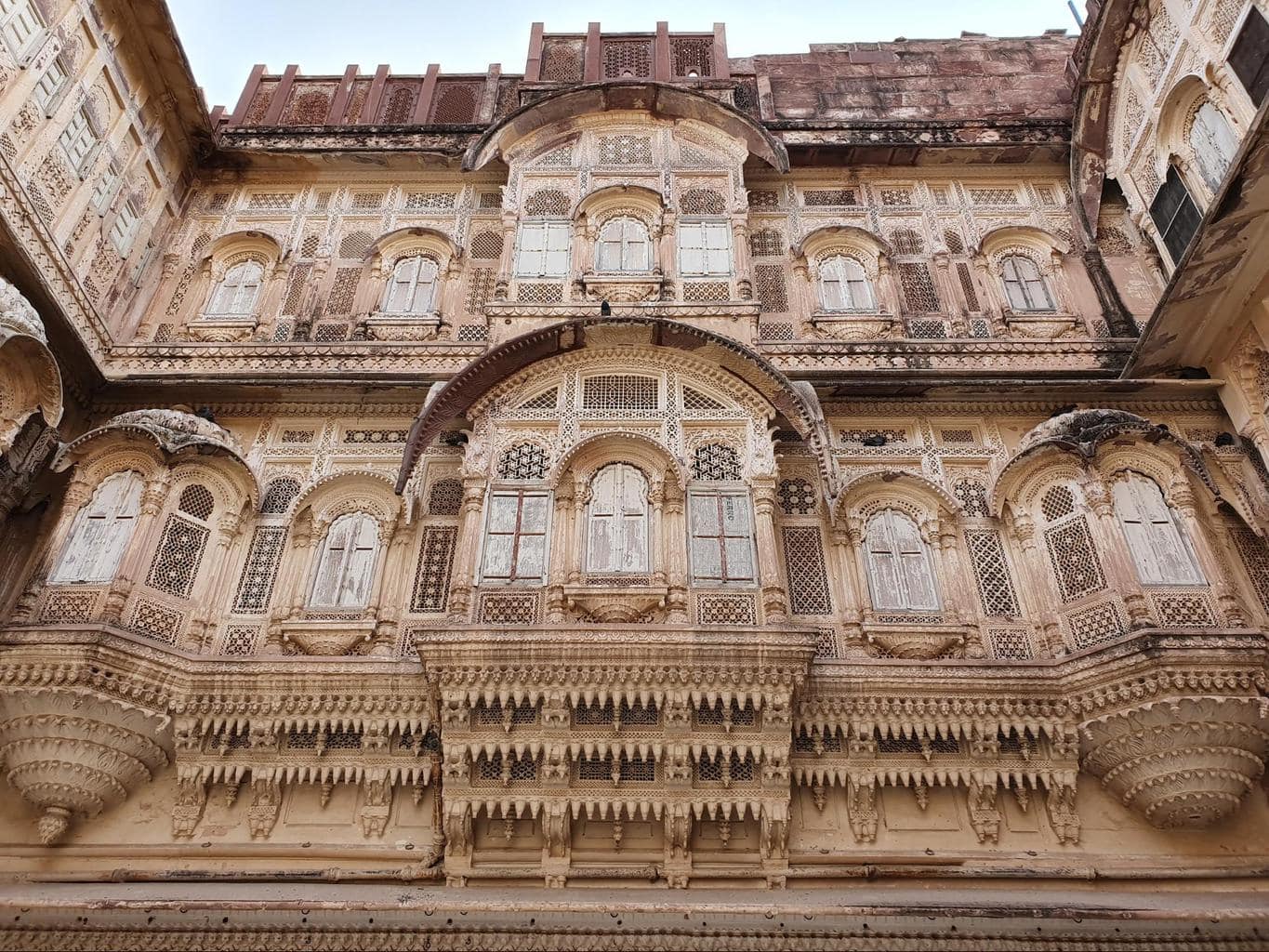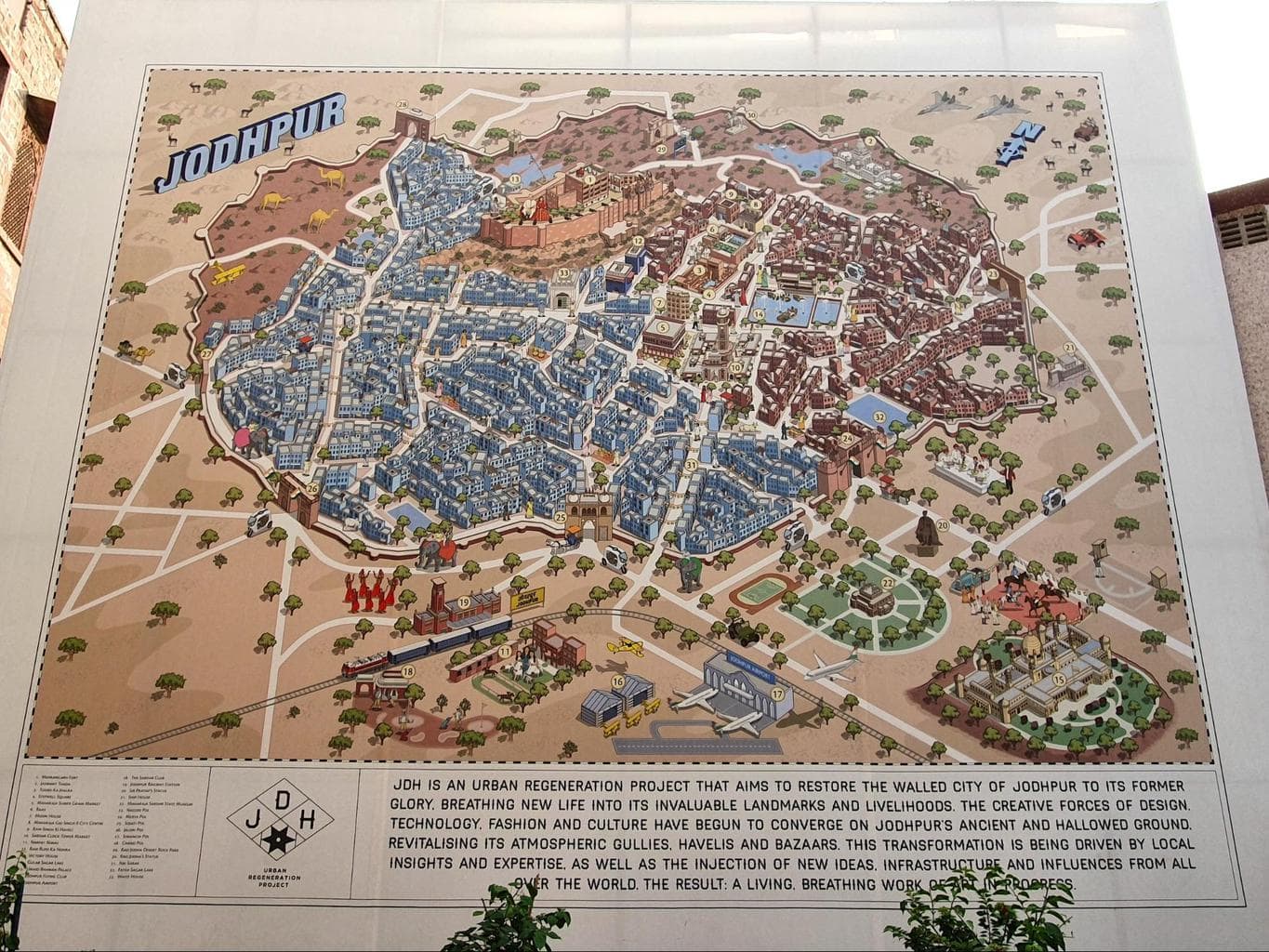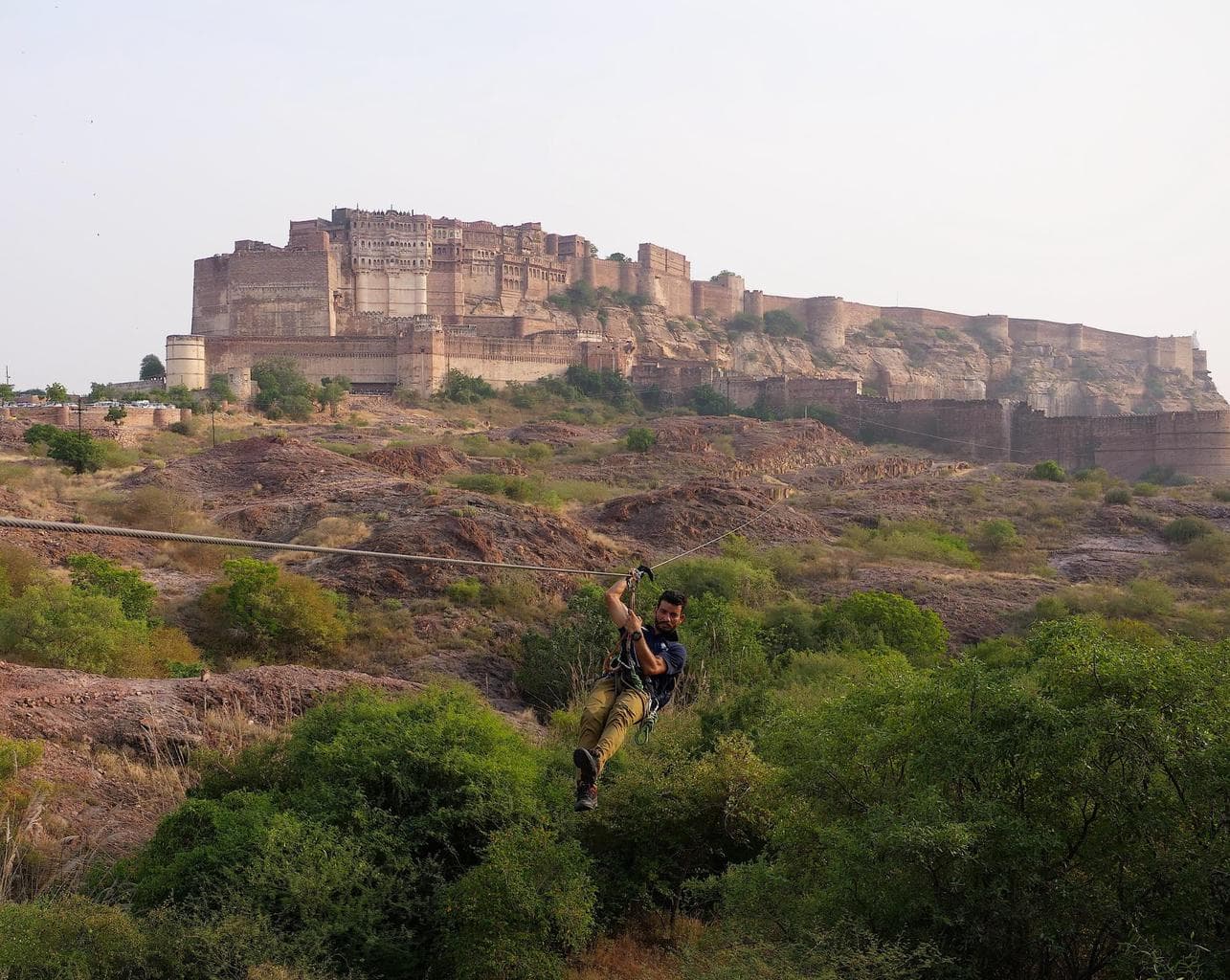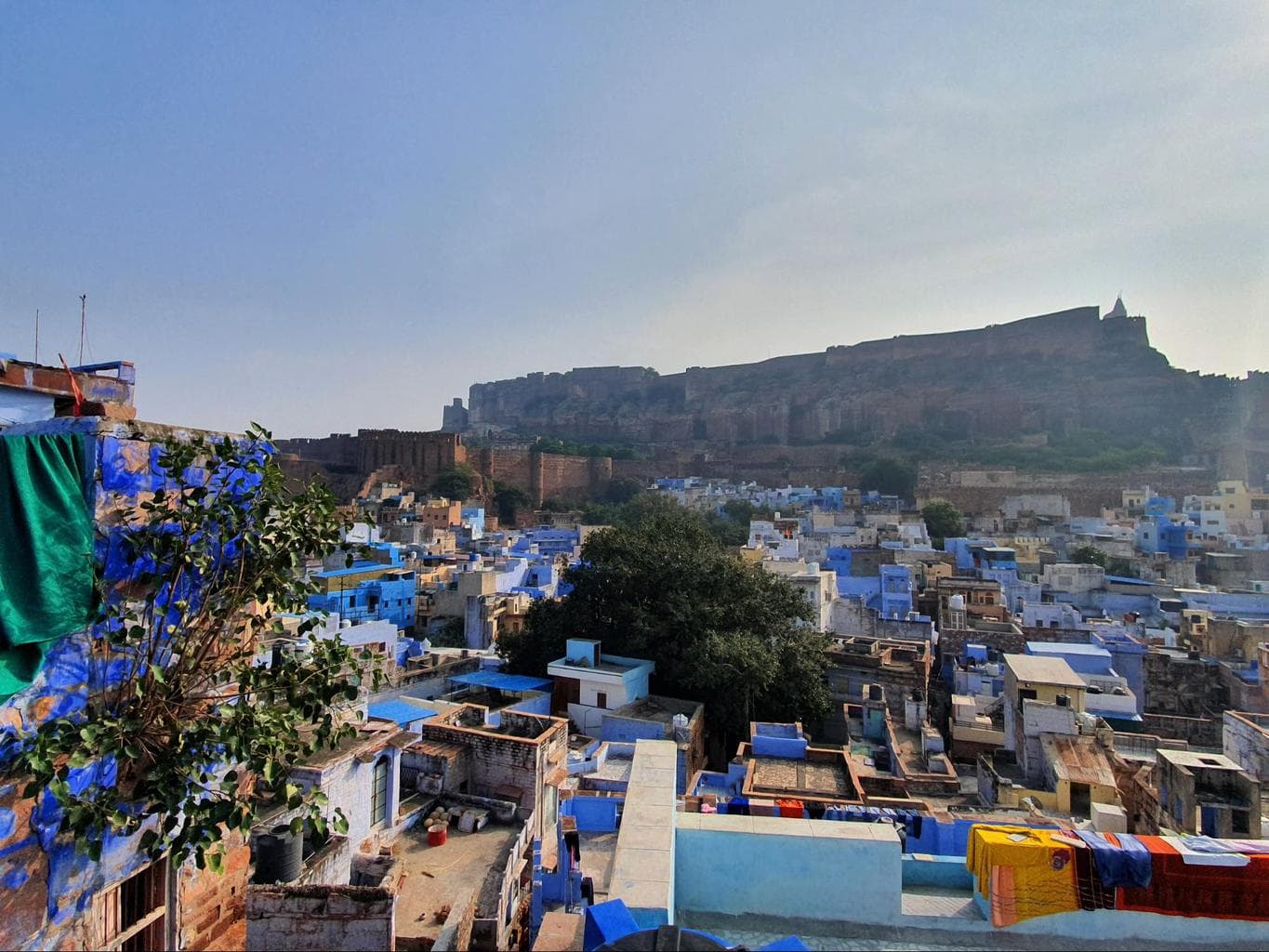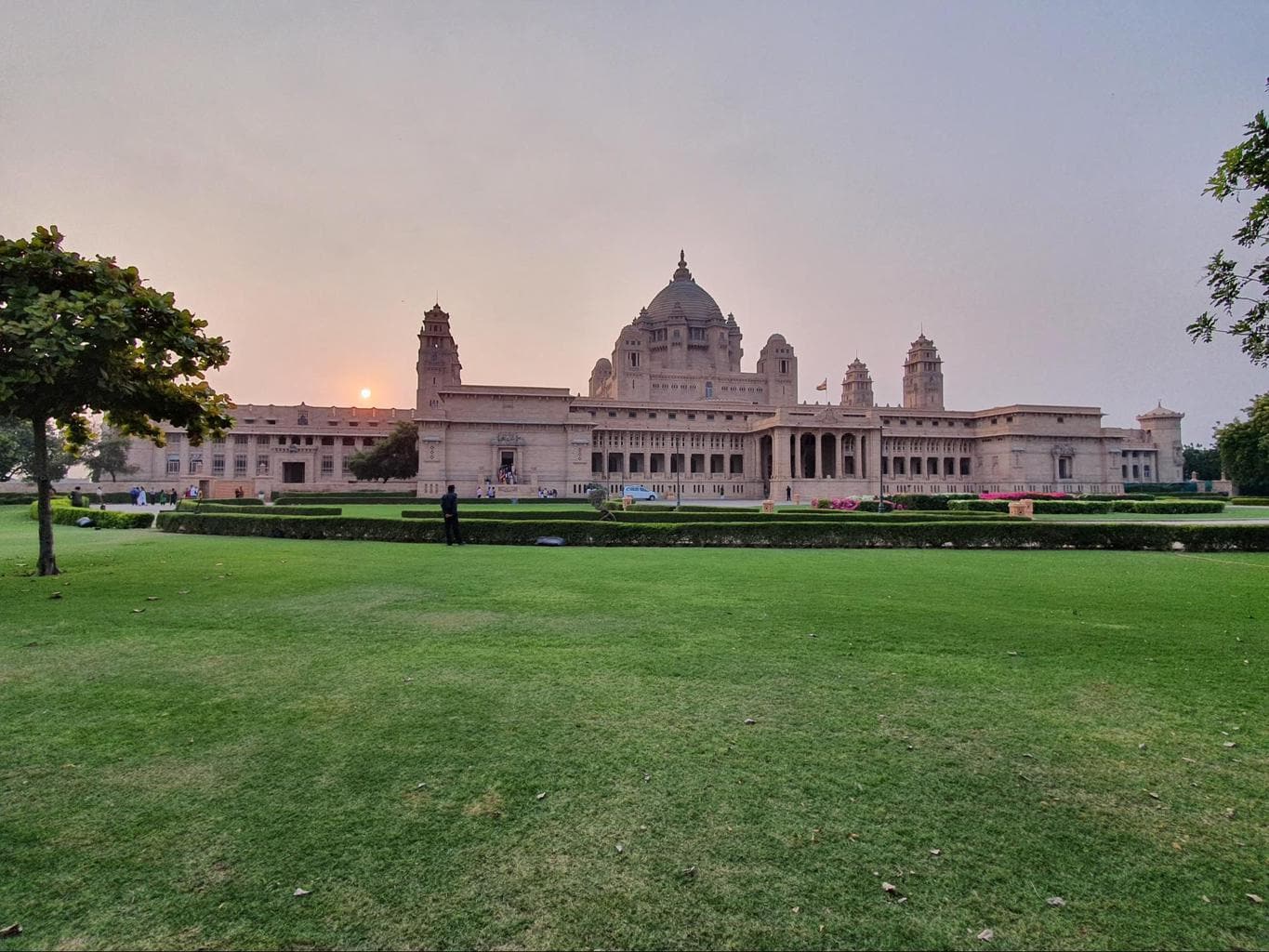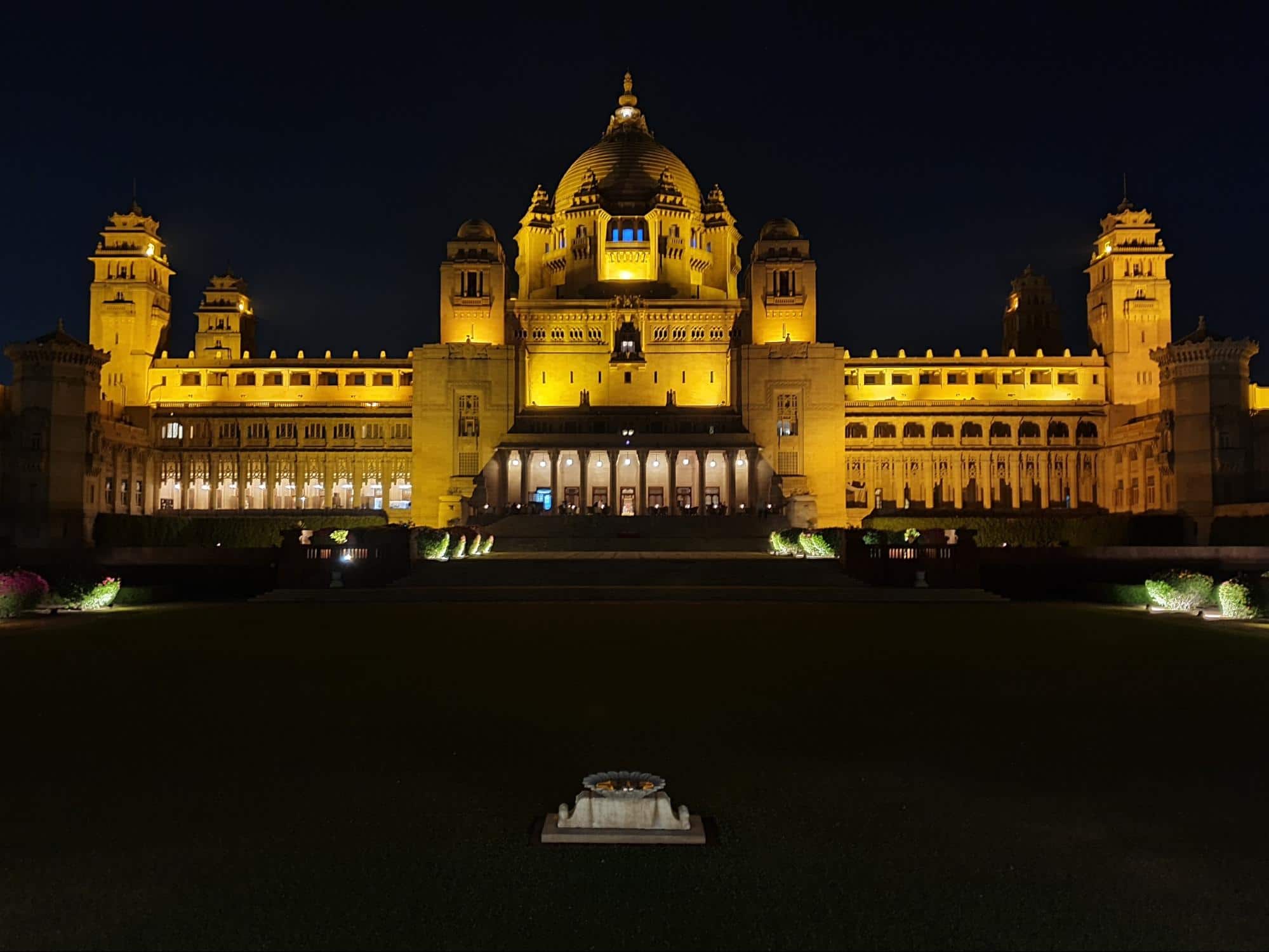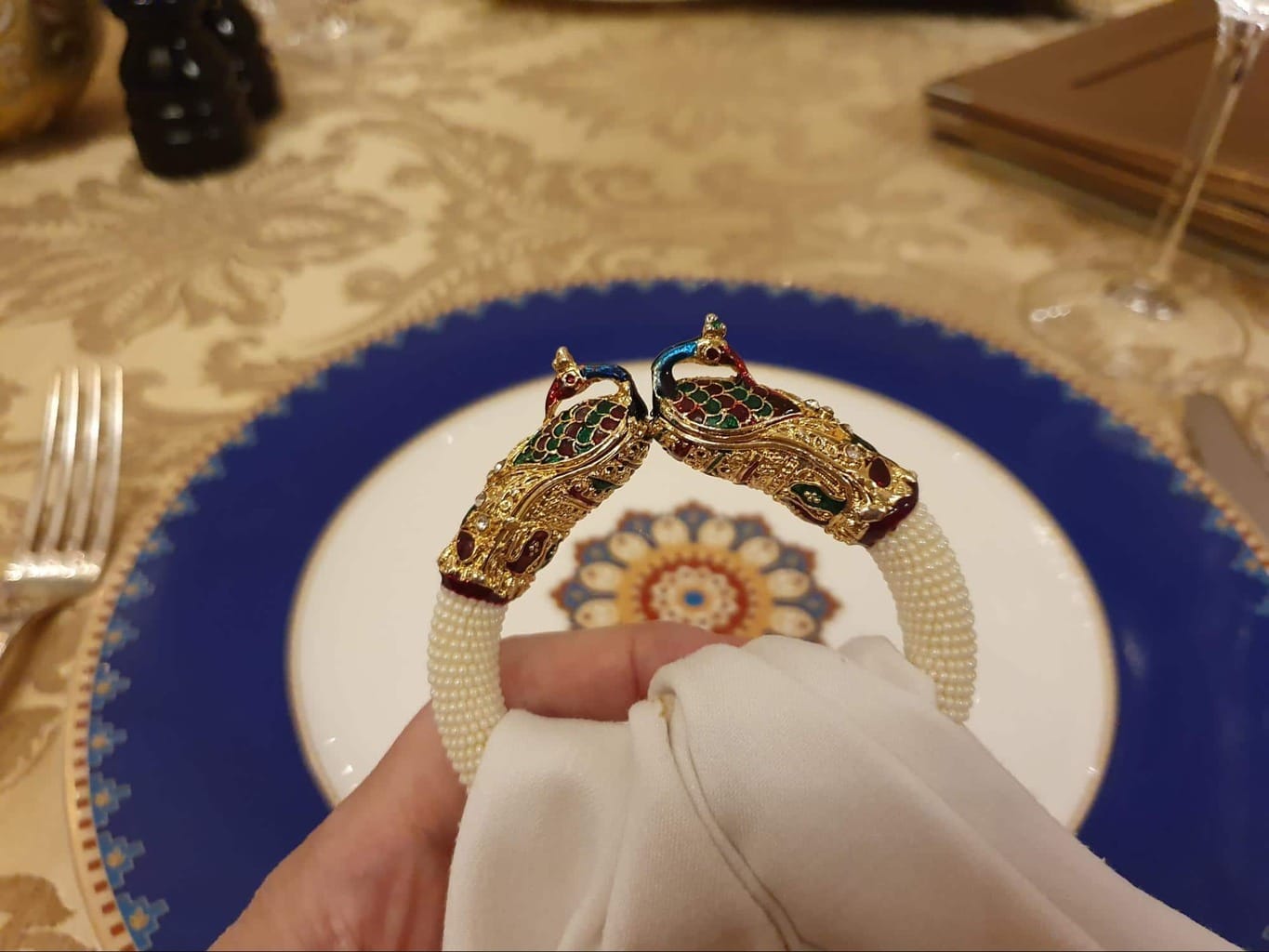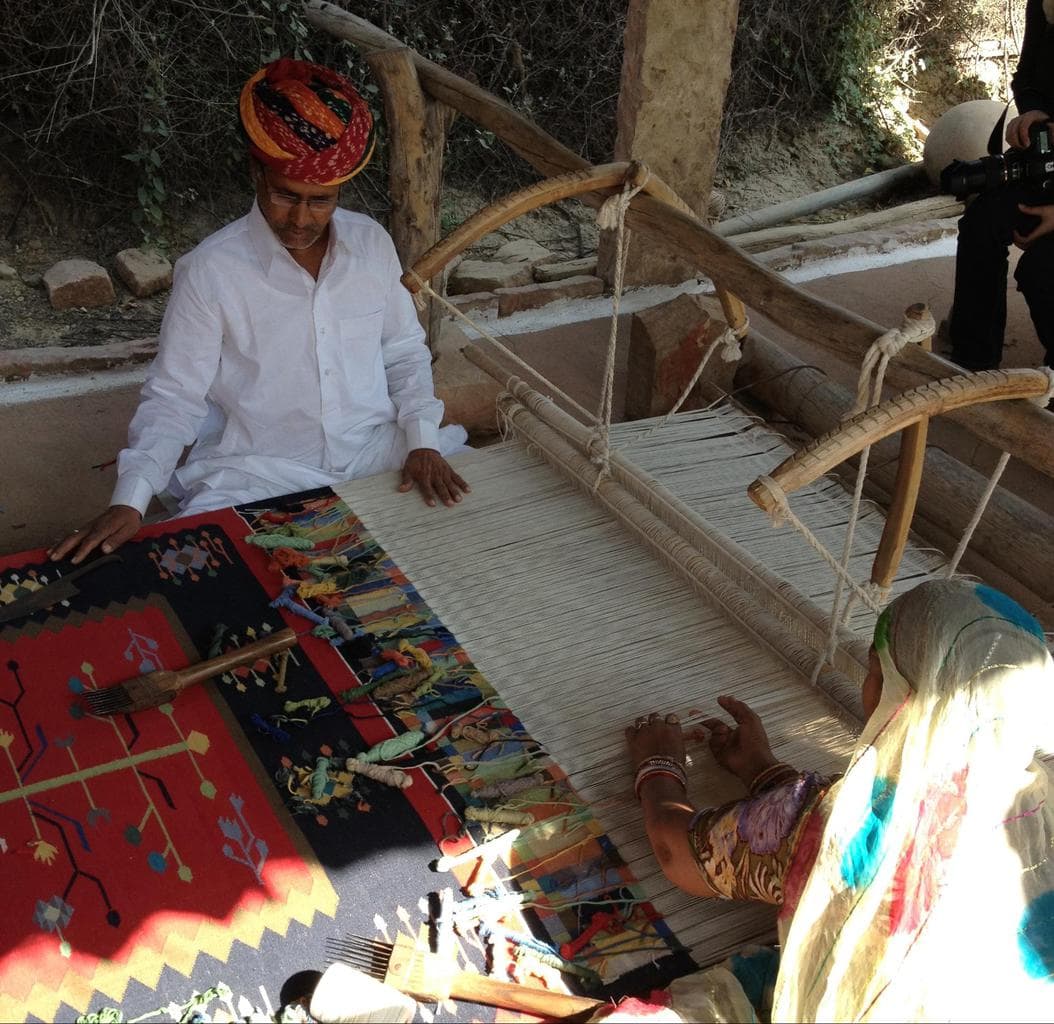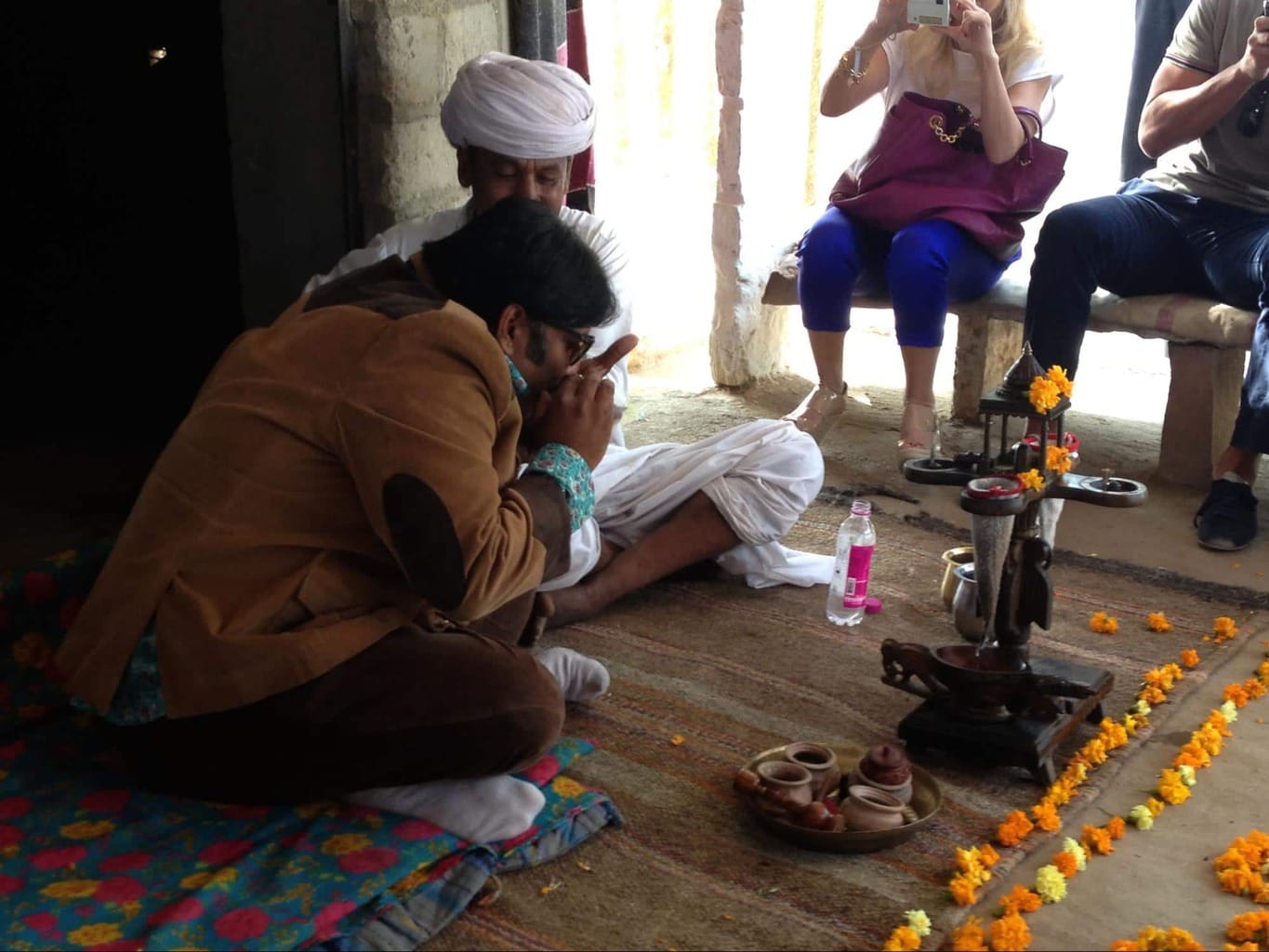Once in a Lifetime Journey was a guest of India Someday and received discounted services for the 2-week trip through Rajasthan for 4 adults and a baby. India Someday specialises in helping you explore India independently and your way. As always our opinions are honest and our own.
If you spent any time planning your trip to Rajasthan you will most likely have come across the Blue City and thought that there were enough things to do in Jodhpur for a couple of days, and you would not be wrong.
Jodphur has a surprisingly well-preserved fort on top of the hill that looks as if it came out of Lord of the Rings or another fantastic story. This may be the reason why it has been featured in many of the movies filmed in India.
But it is not the imposing red fort that gives it its colorful name, but rather the Brahmin houses surrounding it, many of which are painted blue. Find out more about the history and things to do in Jodhpur below.
A brief history of Jodhpur
Jodhpur was the capital of the Marwar Kingdom and a princely state under British rule. Today it is still the second largest after Jaipur.
Like other cities in this part of India, it receives its name from its founder Rao Jodha, who set the city’s foundation in the middle of the 15th century.
It was a century later that Jodhpur was annexed to the Mughal Empire of Akbar although it WAS allowed to maintain its internal control. After centuries of fighting and changes in control, Jodhpur joined the British Empire.
During that time, Jodhpur prospered and benefited from its strategic position along trading routes. This position then evolved from road caravans to trains, which still fetch Jodhpur’s textiles, handicrafts and furniture to the main international air and sea hubs and onto the West.
Today, apart from being a tourism destination (albeit not as popular of Jaipur or Udaipur), Jodhpur is also home to the largest airbase in India and in Asia, thanks to its proximity to Pakistan, close enough to handle an attack but far enough from missile range.
Things to do in Jodhpur
There are many things to do in Jodhpur to keep you occupied for 2 to 3 days and on this list, I will explore them all.
In general terms, Jodhpur is known for its fort, the houses in The Blue City and its food. Several Rajasthani foods originate here and the city is a street food paradise. Naturally, you will find that a lot of the places to visit in Jodhpur fall into one of the three groups above.
Thankfully, the fort and Blue City will help you burn the calories after eating all the delicious food!
Generally speaking, there are three main parts of Jodhpur, the Blue City, the Fort and the Walled City. All the things to do in Jodhpur in this article are in one of these three areas. Then, there are some at the end which are outside the city.
Toorji-Ka-Jhalara stepwell
Toorji-ka-jhalara is stunning stepwell in the old part of Jodhpur adjacent to RAAS Jodhpur that makes for a photogenic spot, it is also one of the deepest stepwells I have ever seen. If you are an avid photographer, this is a must-see place in Jodhpur.
Most visitors to India don’t realize that stepwells are very common and found across the country, there isn’t just one, but dozens.
Some of them have become famous because they have been used in movie scenes or Bollywood dances, but if you spend enough time in Rajasthan you are bound to find a few. I visited three including this one, Abaneri outside of Jaipur and the one right by the fort in Jaipur.
What makes Toorji-ka-jhalara quite interesting is not only its depth but also the fact that one of the sides has a balcony. Usually, step-wells are the same on all four sides and have stairs that seem to be playing a 3D game on your mind.
Most step-wells were built by Queens and were the place for women to come and this one was no exception. Constructed in 1740, it was only rediscovered and repaired recently, in conjunction with an urban development project spearheaded by RAAS Jodhpur which has breathed new life to this part of the city.
It is common to see kids playing around the well and jumping in the water as there seems to be a permanent supply of it through the underground channels. Right after I was there, Red Bull filmed an epic video which you can see here.
The best time to come here is in the morning when it is less busy. However, beware that the well will be half in the shade then so you will have to play with this. There is no ticket entry to this as the step-well is open to all.
Look at the Ghanta Ghar clock tower and Sardar market
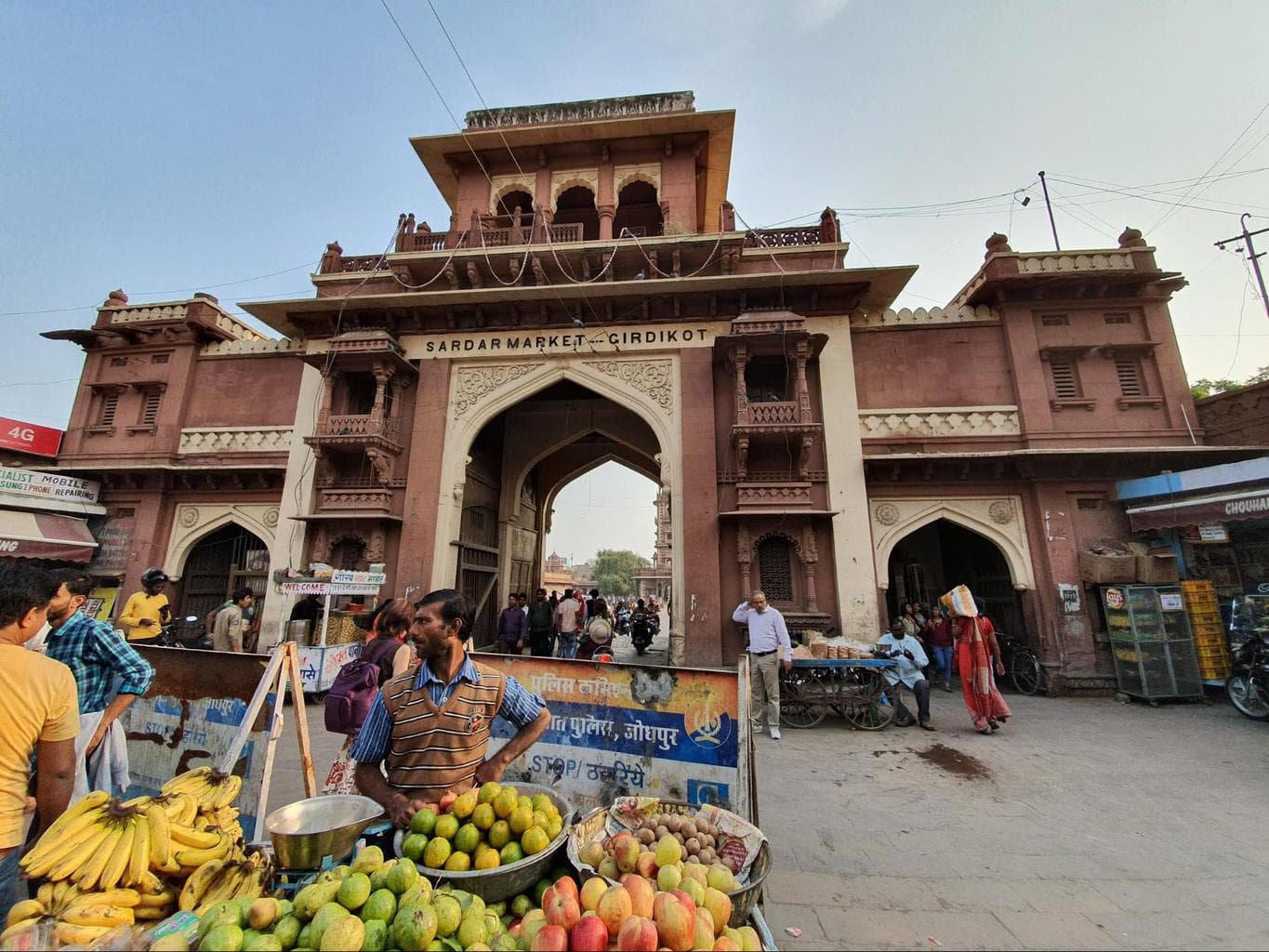
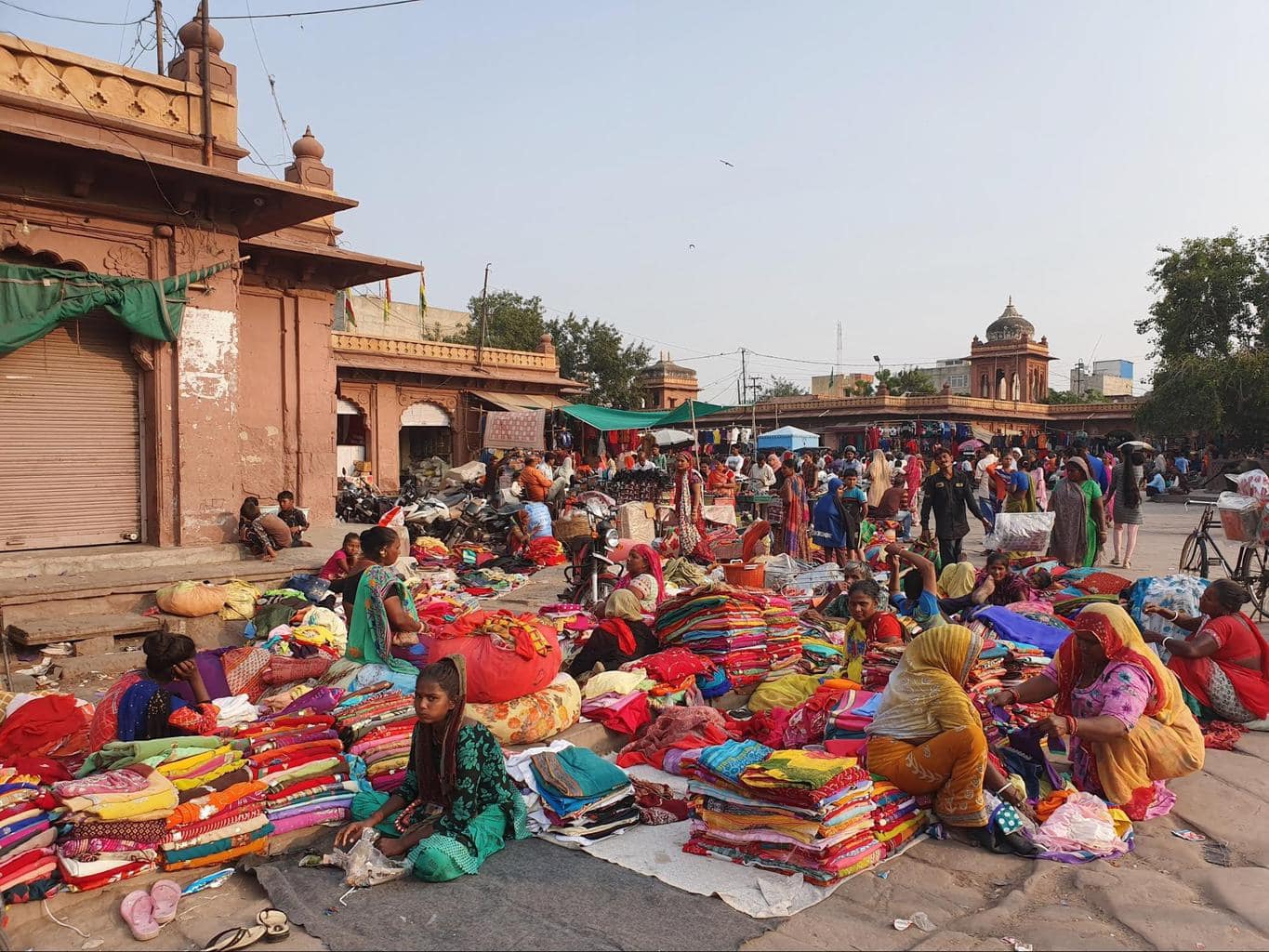
Jodhpur was and still is a major trading point and its markets are huge and everywhere. One of the best ones to get lost in is Sardar market, a market located around the clock tower.
Here you can buy street food, fruits and vegetables, silverware, as well as new and used clothing, a second-hand sari costs just a dollar. Markets are my favorite and I always look out for them wherever I go. Naturally, this was one of my favorite things to do in Jodhpur.
The market got its name from the Maharaja who built the tower at the end of the 19th century. This is a proper market, with permanent buildings surrounding the clock tower and subsequent street sellers spilling onto the road.
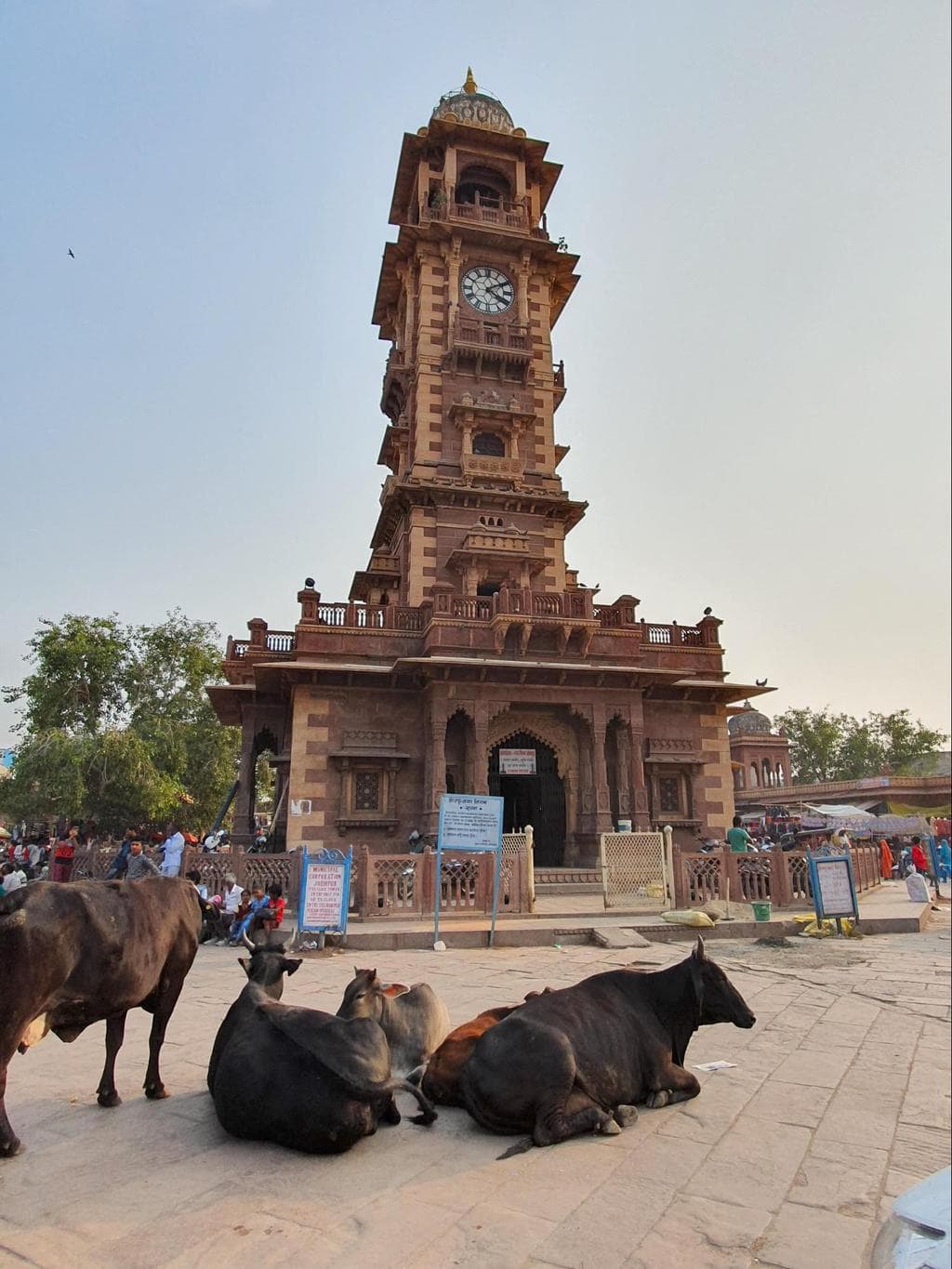
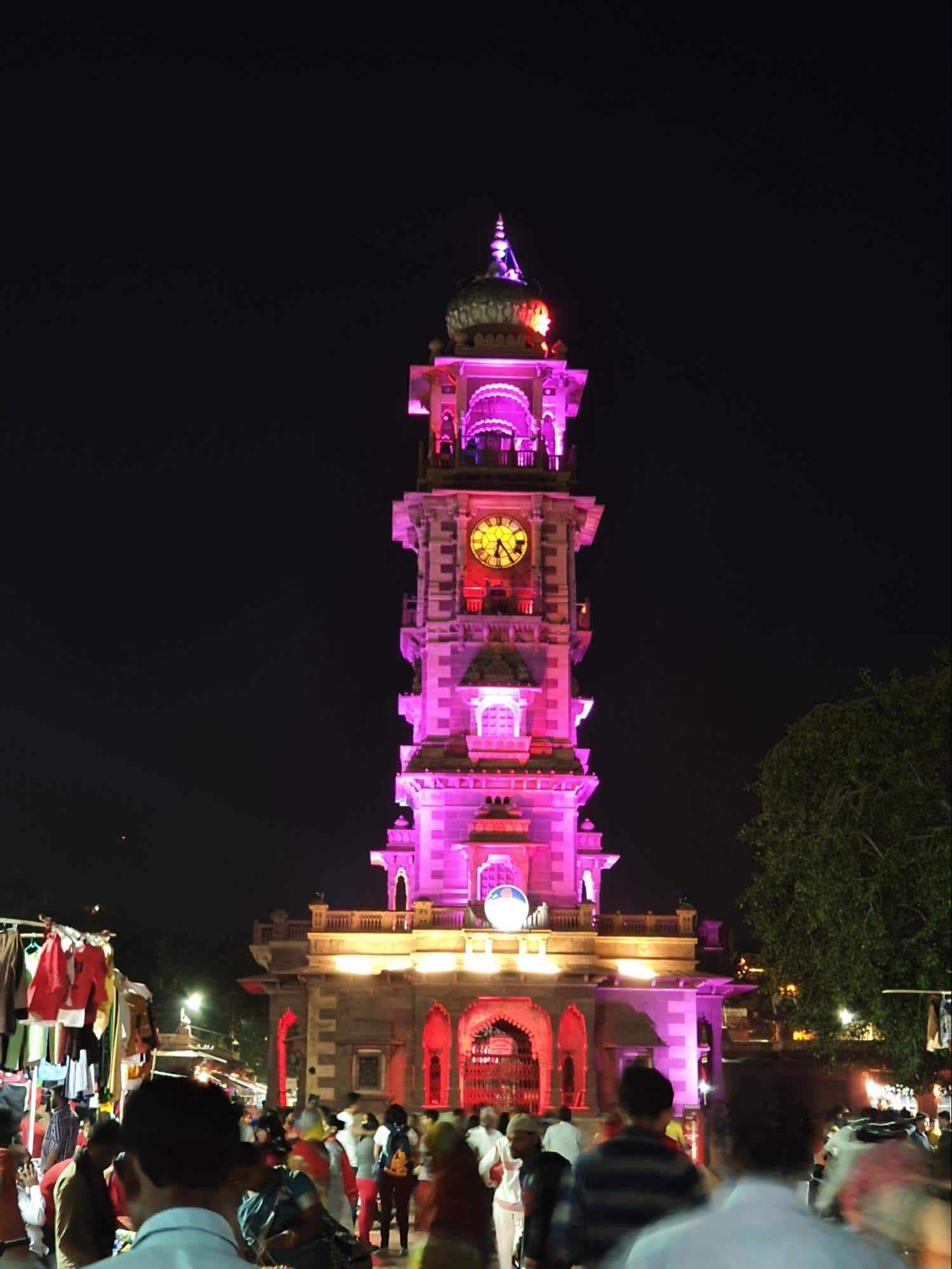
Ghanta Ghar, the name of the clock tower, is brightly lit in all colors at night and absolutely packed during the day. It is almost impossible to walk around when the market is in full swing.
Luckily, this does not happen until after 10am so if you are after the tower only, come earlier and you will find the square empty and clean.
The market is flanked by two triple-arched gateways that control the traffic flow. Only smaller cars, rickshaws and motorbikes can go through the main door and pedestrians through the side ones.
The market starts at 10am and goes until late at night. Beware of the crowds, the cows and the traffic that comes from everywhere. Afternoons are particularly packed.
Have a romantic dinner with fort views
Because the fort is located on top of a rocky hill and towers above the city below, there are a few rooftop locations for dinner with stunning views. After a long day exploring all the places to visit in Jodhpur, you will welcome a good meal with hopefully great company.
RAAS Jodhpur is very close to the fort’s base and has a rooftop restaurant with fantastic views and great food, the service was also exceptional (e.g. preparing a dish again because it was too spicy for my mum).
Pal Haveli is another luxury hotel in Jodhpur, very near RAAS, with a rooftop restaurant called Indique that has panoramic views. They are both open to non-guests with a booking.
Book directly with your choice of hotel.
Sweet out at Janta Sweet Home
This legendary sweet store in Jodhpur is where the locals go to satisfy their sweet tooth and you will be able to fill yours too. Rajasthan is known for the drier types of sweets and for them being even sweeter than in other parts of the country.
Try the local specialty kachoris, fried bread dumplings filled with dal and mung beans, and dipped in sugar syrup to make it sweet. And don’t forget to try Mirchi bada, deep-fried green banana peppers that look like large jalapenos and are mildly spicy and filled with mashed potato and cauliflower. They are addictive.
The shop is also famous for its many Indian snacks, called namkeen, these are usually savory and enjoyed with a drink or as a welcome snack given to guests. You can find all sorts of namkeen all over India, they are also available for sale everywhere, they are the Indian version of Western chips.
Janta Sweet Home also sells its products to take away in packaged boxes. The shop opens from 8:30am to 11pm so makes for a great thing to do in Jodhpur in the evening if you are trying to make the most of your day.
Visit the Royal Mehrangarh Fort
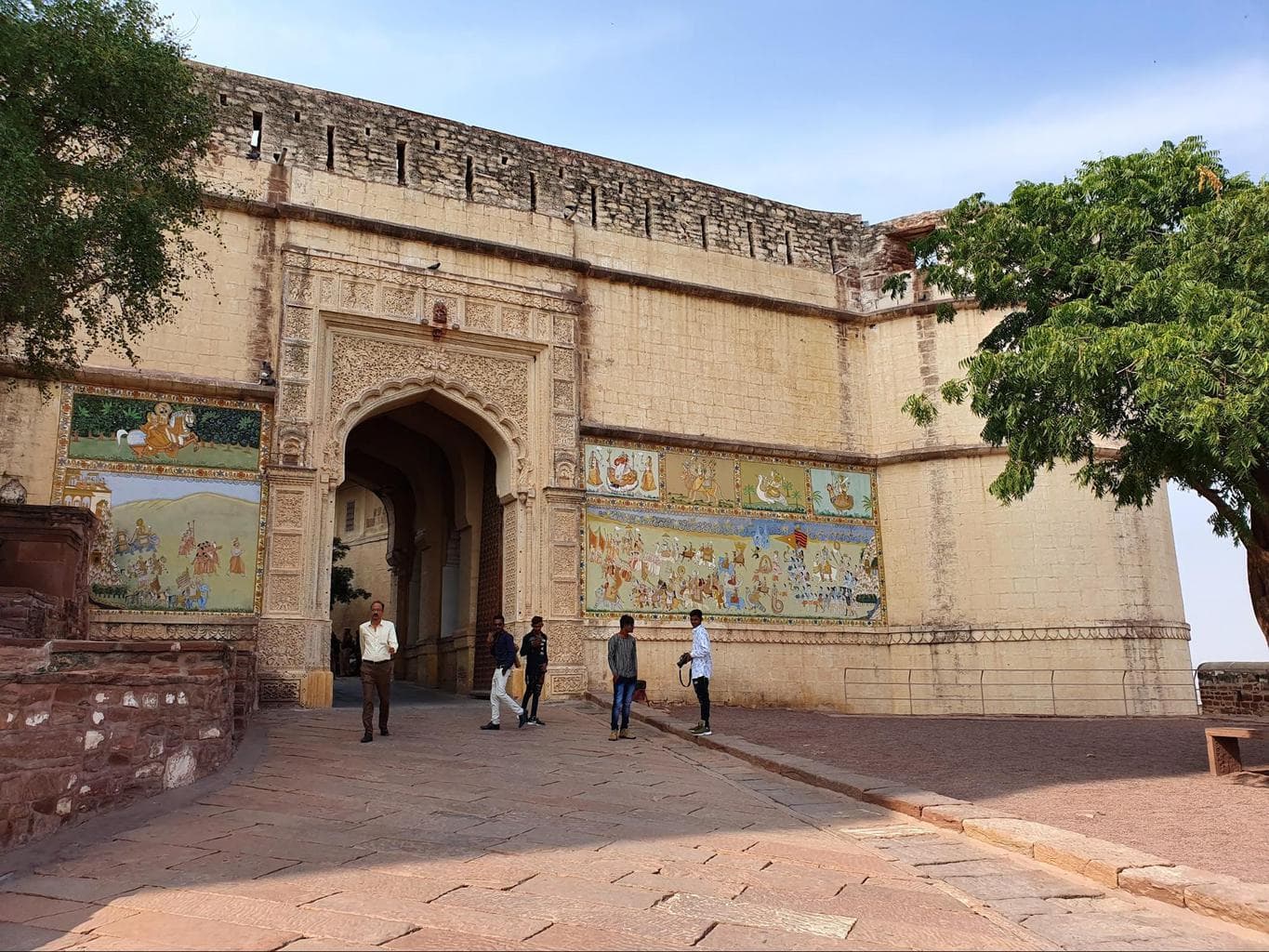
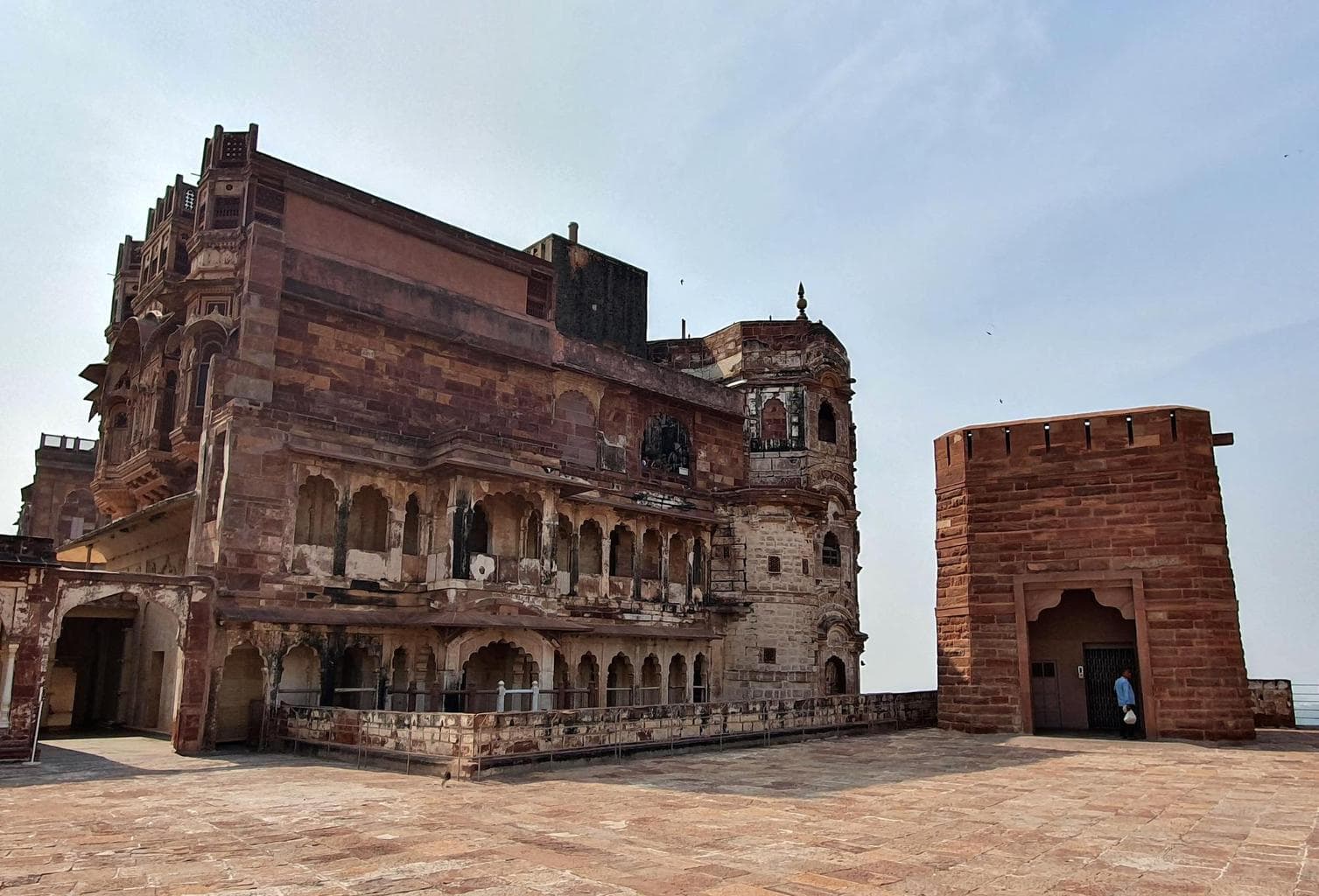
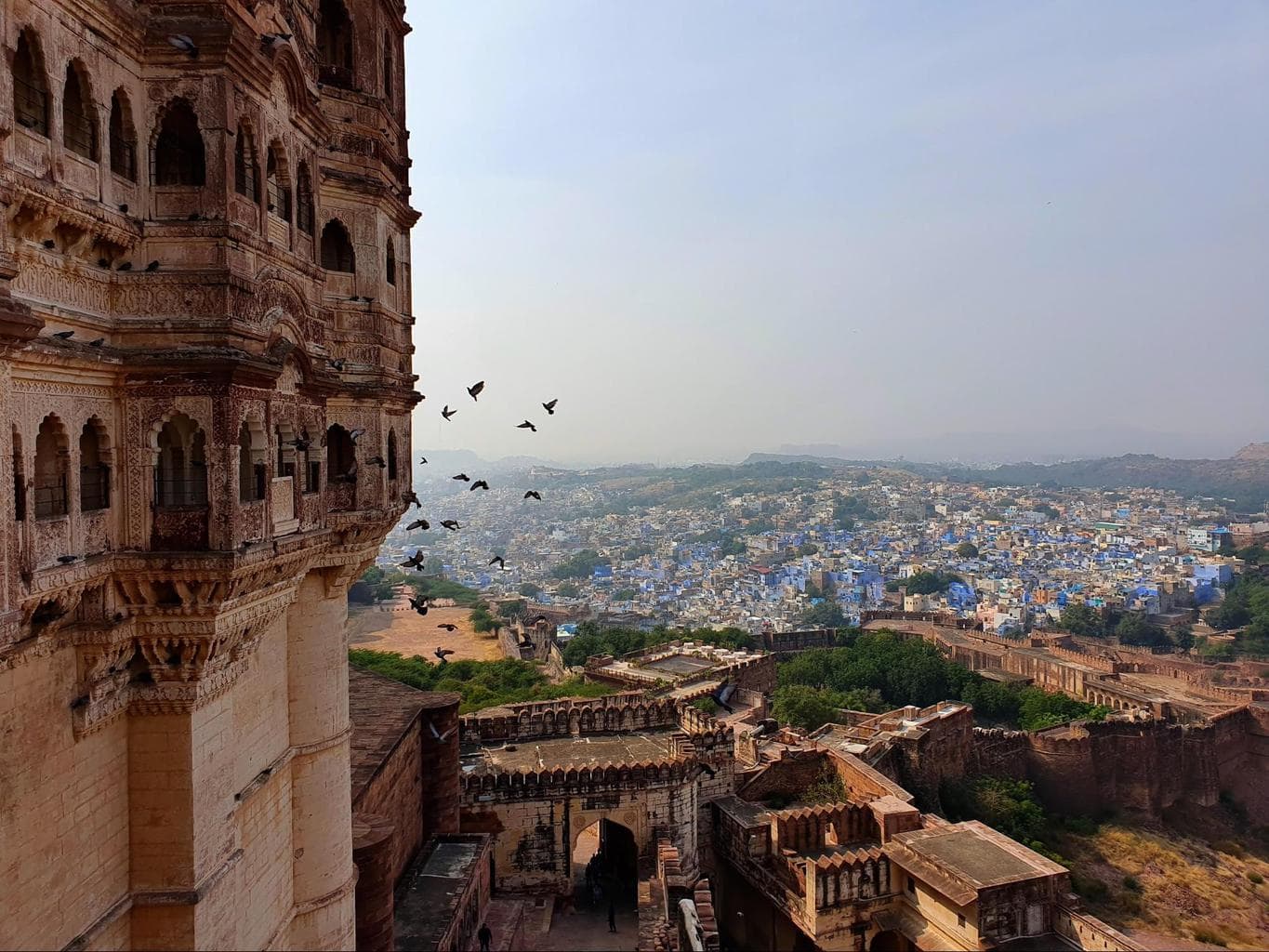
Mehrangarh Fort is the most recognizable landmark in the city and a must-see attraction. As soon as you get there, you will agree with me that visiting the fort is the best thing to do in Jodhpur.
The fort was built at the time of the city’s founding and is located on top of a hill 125m above the ground. It stands tall and imposing above the rest of the city and it can be seen from any viewpoint around it.
The foundation of the fort was laid by a sage, Shri Karni Mata, at the request of Rao Jodha, who managed to evict a hermit who was living on the hill and had refused to leave. On his departure, he is said to have cursed the fort with drought.
Apart from being an imposing architectural masterpiece, the fort was constructed with two types of stones, white sandstone that is typical of the area and dates back 500-600 million years ago and a pinkish-red volcanic rock from the volcanoes that were active around Jodhpur 700-600 million years ago.
You can see the two types of materials used if you observe the facade of the fort. Look for a sign by the elevator that explains this phenomenon that geologists call an “unconformity”, that is two types of rocks that are in contact with each other but which belong to non-consecutive periods in history.
The fort’s name comes from the Sanskrit for Sun Fort which is why the city is often referred to as Sun City as well as The Blue City. This name is attributed to the fact the Rathore clan Rao Jodra belonged to were descendants of the Sun God (Surya).
Although the fort was founded in the 15th century, most of what you can see today dates from the 17th. Some parts of the fort were built even after. Today’s custodian is the descendant of Jodha, Maharaja Gaj Singh II.
The entry ticket will give you access to the fort’s main palaces which have similar names to those in the rest of Rajasthan and also look similar, with bright stained glass and Belgian mirrors. Sheesh Mahal (Mirror Palace), Moti Mahal (Pearl Palace) and Phool Mahal (Flower Palace) are the most impressive.
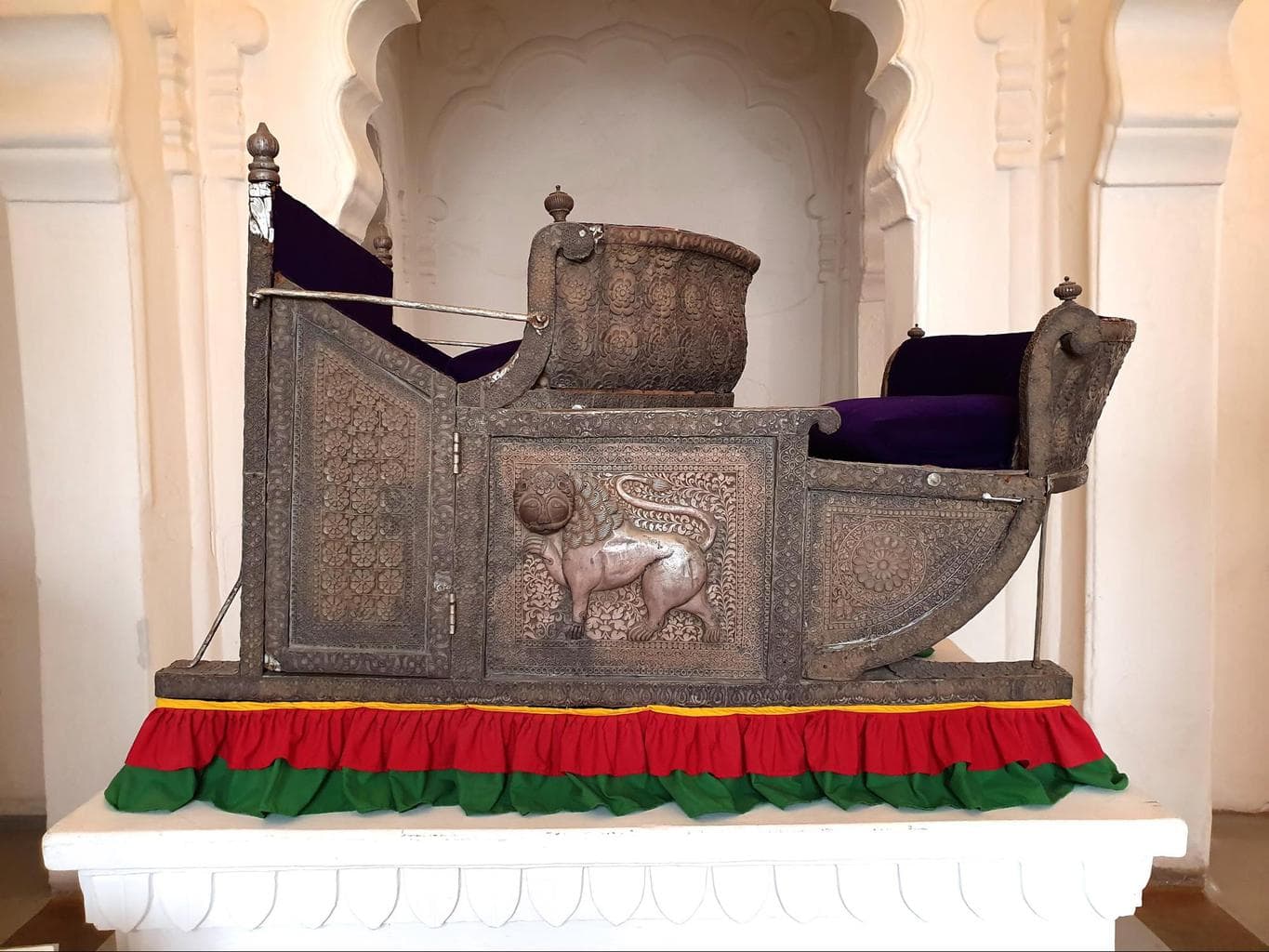
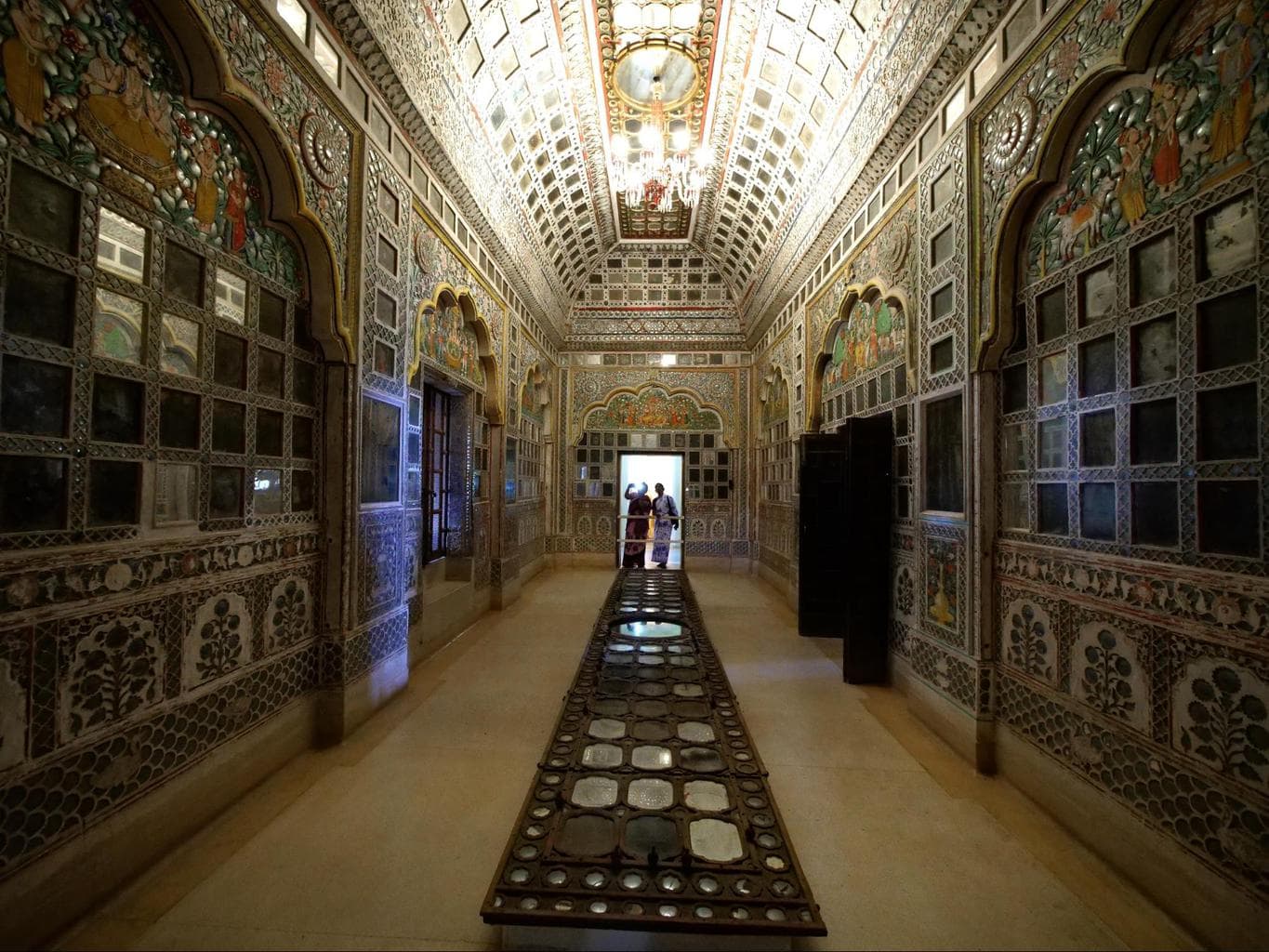
Phool Mahal was built in the 18th century as a private hall of audience and is possibly the most impressive of the rooms. The ceiling here has been decorated with gold and filigree, you have never seen such a level of detail. The walls are painted to represent Indian ragas.
You can also see the Maharaja’s room, Thakas Vilas, which is so overly decorated it even has disco balls hanging from the ceiling, and the floor is painted as if it was a carpet. In the afternoon, when the light comes through the stained glass it’s something out of a romance movie.
Next to it, befittingly, we were invited by a local artist to hear his meditation music. He played his unique instrument for just 5 minutes for us and even the baby went quiet. A raga is a form of traditional Indian music of Rajasthan that is made with a string instrument that is like a rectangular guitar with one side shorter than the other.
Have panoramic views of the city below from the many viewpoints, especially the Blue City that is behind the fort and can be seen from the panoramic viewpoint upon exiting the elevator. You can also see the fort’s walls from there.
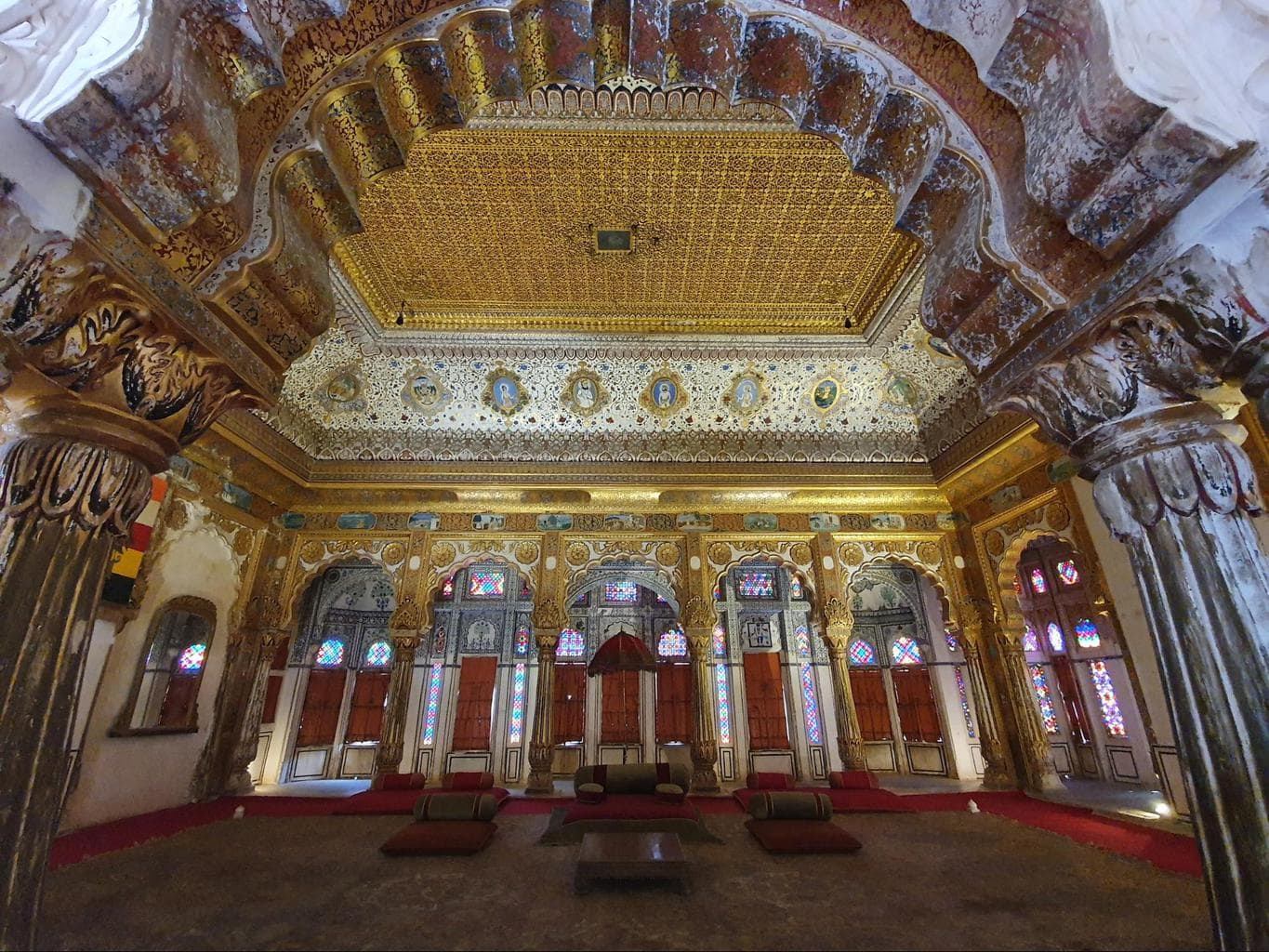
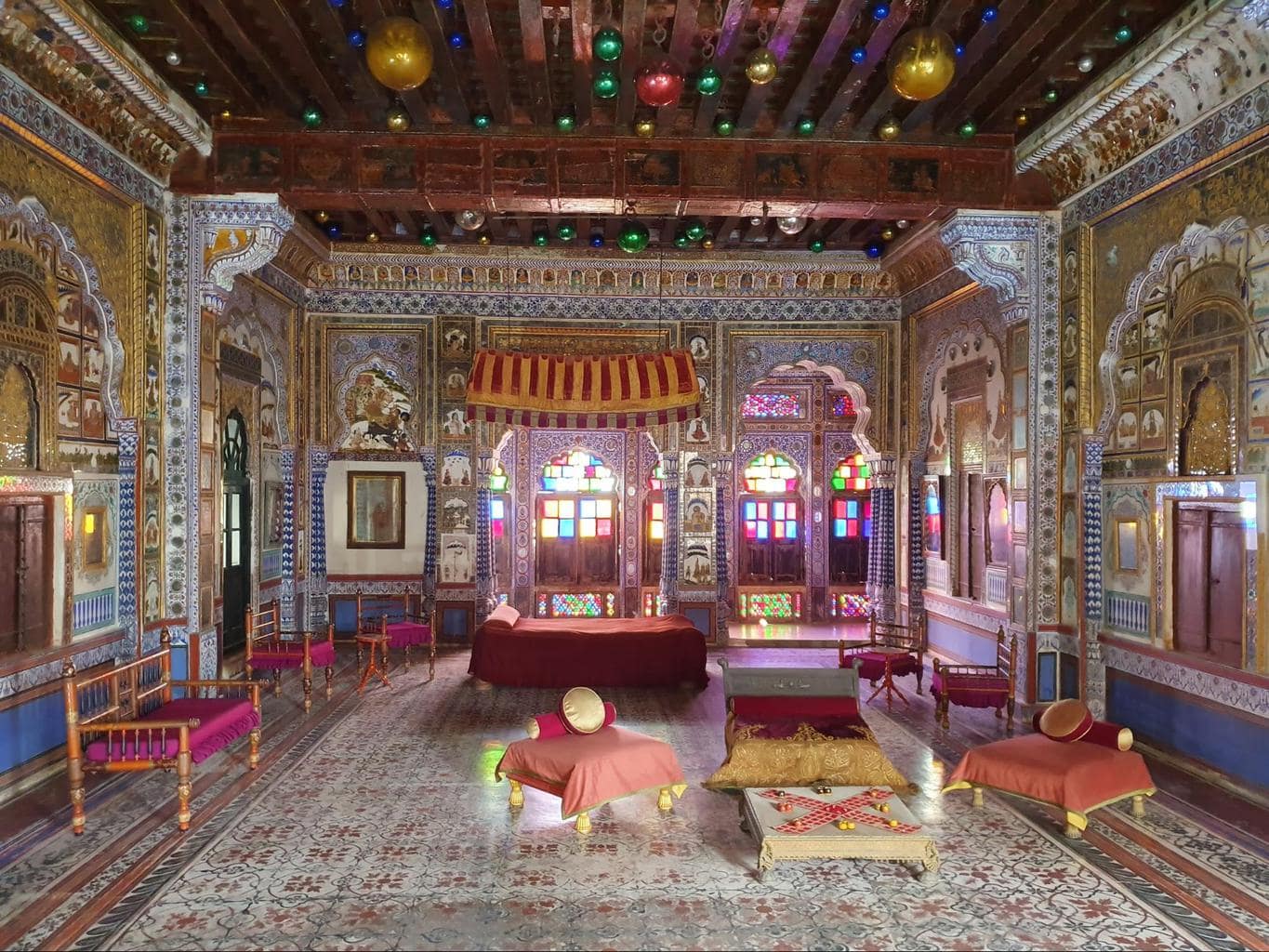
Don’t leave without visiting the fort’s museum which holds one of the most impressive collections in Rajasthan. Admire the miniature paintings on display and learn how they were made, you have never seen a painting brush so thin.
The museum also holds a large collection of palanquins and howdah (elephant seats) from all parts of India, royal costumes, opium and perfume boxes, etc. The armory which displays swords from all over the world, even from Mongol Timur.
The howdah are particularly interesting. Note how they used to have two compartments, one of the King and one for an attendant that doubled as a bodyguard in case of need. Look for the silver howdah given by Shah Jahan to Maharaja Jaswant Singh in 1657 along with 100 horses.
More information about the fort here.
The best way to visit the fort is on a guided tour so that you can get commentary from a guide and transportation to the site (it’s 20-30min from town). Here are some of the best tours available on GetYourGuide that include the fort:
- For the convenience of an all-inclusive experience, book a private tour of Jodhpur with a guide, all entry tickets and lunch. This tour includes the fort, Jaswant Thada, the Clock tower and Mandore Gardens. Book it here.
- Private tour of Jodhpur including the fort, the memorial, Umaid Bhawan. This tour does not include a guide, food or entry tickets, just transportation. Book it here.
- Private day tour of Jodhpur including the fort, the memorial, Umaid Bhawan and then in the afternoon, the Bishnoi villages. The tour includes driver and guide but no lunch. Book it here.
- Private tour of Jodhpur including the fort, the memorial, Umaid Bhawan followed by a desert camel safari in the evening. This tour does not include a guide, food or entry tickets, just transportation. Book it here.
You can buy the ticket from the entrance for 600 rupees and decide to get the elevator up to the viewing platform for a small additional fee (50 rupees) or walk up the steep but not too long path through the fort’s seven gates.
Guides for hire are available onsite for 400 rupees for up to 4 people and audio guides for 180 rupees. The fort opens from 9am to 5pm.
There is one cafe in the fort complex that serves Indian and international food and bathrooms that are relatively clean. Another cafe, Vaara Cafe, is located at the end of the museum tour and by the entrance to the souvenir shop, sheltered by the shade of the courtyard.
The souvenir shop here is the best we saw anywhere in Rajasthan and sells exquisite items such as miniature paintings, clothing, pashminas, jewelry and all kinds of high-quality souvenirs.
Shop for beautiful souvenirs
There are two main places to buy premium souvenirs in Jodhpur. One is the shop in Mehrangarh Fort which is exquisite, and the other is a group of shops which are part of Jodhpur’s Urban Regeneration Project (JDH) and located around the step-well and RAAS hotel.
In both cases, expect to pay higher prices for higher quality items that you will actually still love when you get back home. Pieces are made with attention to detail and are more exclusive. There is usually no bargaining here as prices are fixed.
JDH is a project started by three Indians, two local to Jodhpur and one a school friend, who decided to do something to preserve Jodhpur’s old structures which were decaying with the passing of time.
They started with the conservation of the step-well and continued with the opening of RAAS, now a chain of 3 hotels all in heritage locations. The project aims to breathe new air to the area while channeling revenues back into it. The shops are not only beautiful but also sell very pretty things you will want to buy. If you stay at RAAS, you will get a discount voucher.
Feel good knowing that the money collected at the museum shop goes towards the conservation of the fort and that the products sold in the JDH area benefit the community and the funds are used to regenerate and preserve the walled city.
Lastly, if you are more into spices, India is the place to get them. There is a shop on the road that is directly in front of the three-arched gateway of the market, in the walled city, called MV Spices and which was recommended to us by several people.
They have a huge array of spices and teas and this is where you can get everything you need to replicate the Indian dishes back home.
The shop at the fort closes with the fort at 5pm whereas the shops in the walled city close around 8pm so they make for a great stop after the sightseeing is done.
Zip-line around the fort
One of the best things to do in Jodhpur is to explore the outer parts of the fort on a zipline. This is quite a unique way to see the fort and the Blue City below and it is sure to give you great memories.
The company running these tours is Flying Fox and they are located within the fort following the path down from the cafe. The adventure takes about 45min on six zip lines of varying lengths that cover the back end of the fort.
Book the tour directly with the company here.
You should wear closed shoes (you can borrow a pair if you don’t have them) and you will be asked to leave all your belongings in a locker. You can bring your camera with you, as long as it is attached to a strap and hanging from your neck. No selfie sticks are allowed.
The excursion should be booked ahead of time but a day tends to be enough. Do it in the late afternoon for the best light and less heat, there is no shade.
Admire the Jaswant Thada memorial
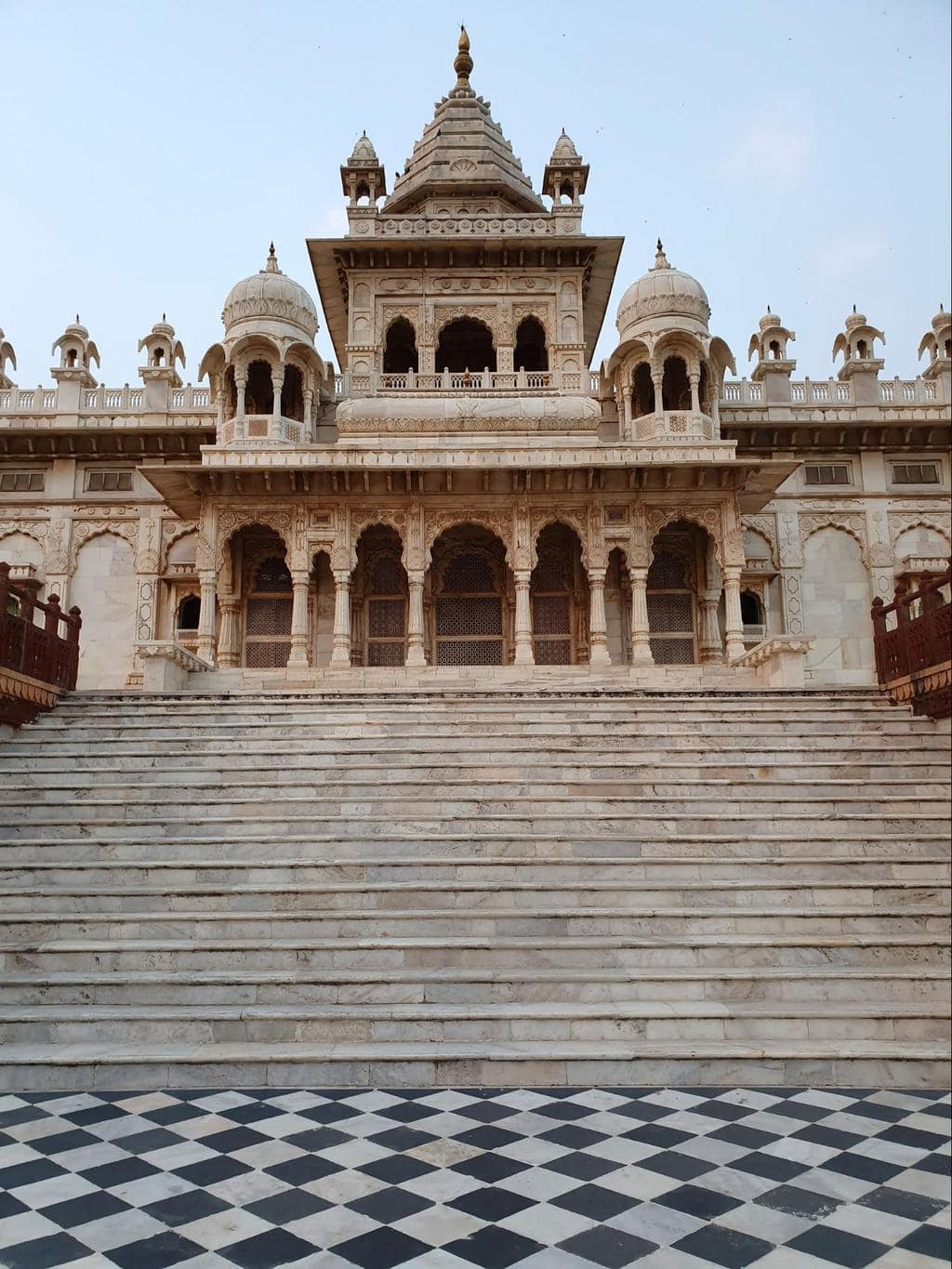
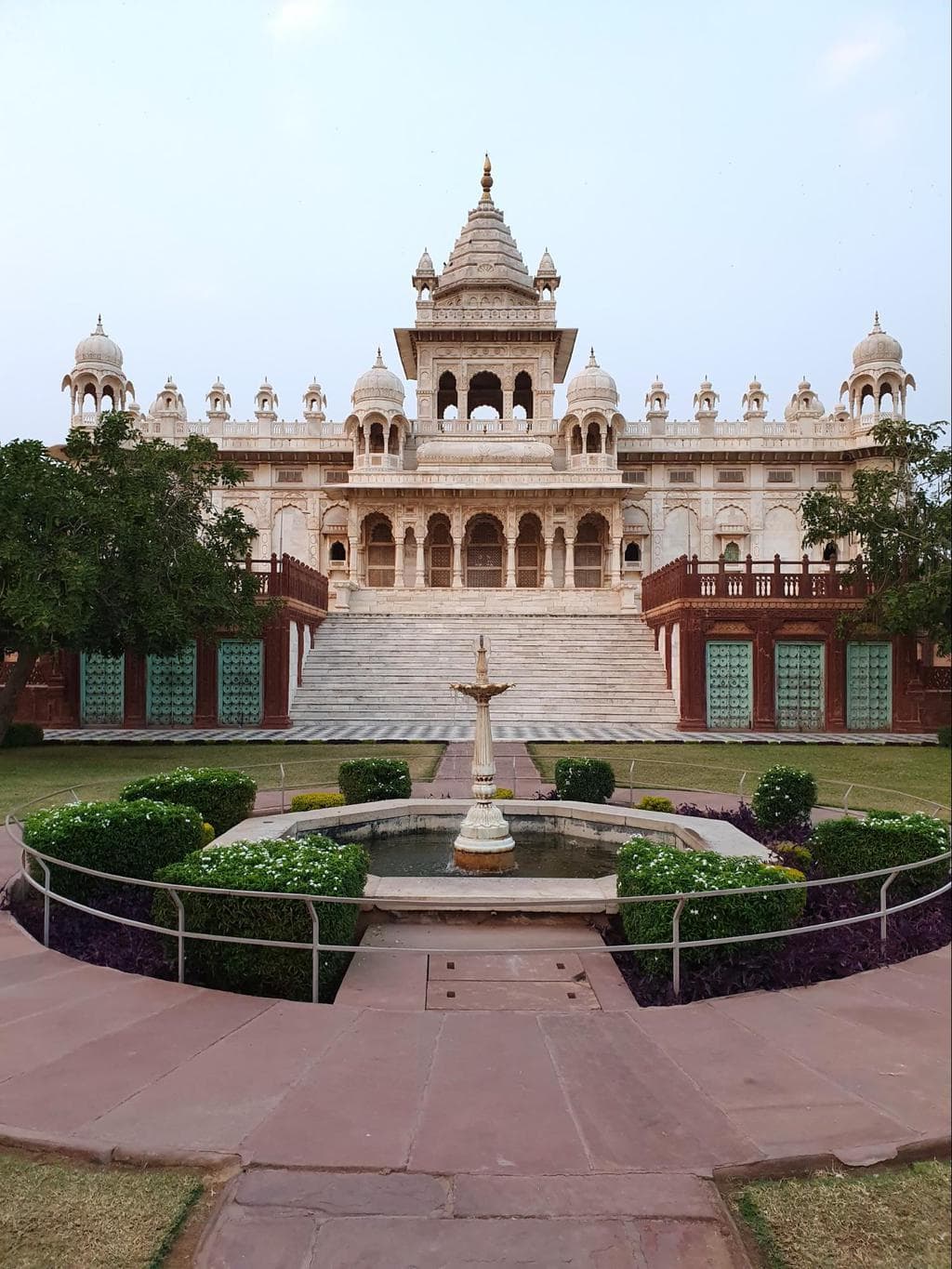
This memorial and Chhatri park located outside Mehrangarh Fort is often referred to as the Taj Mahal of Rajasthan because it is entirely made of white translucent marble.
The complex is beautiful and its location by a pond and near the fort gives great views of it and the city below. Like in other parts of Rajasthan, the main memorial is made of white marble because it was devoted to the King, other materials are used for other family members.
Despite its appearance, resembling the Taj Mahal, Jaswant Thada is relatively new by Rajasthani standards. The memorial was built in 1906 for Maharaja Jaswant Singhjill of Jodhpur by his son.
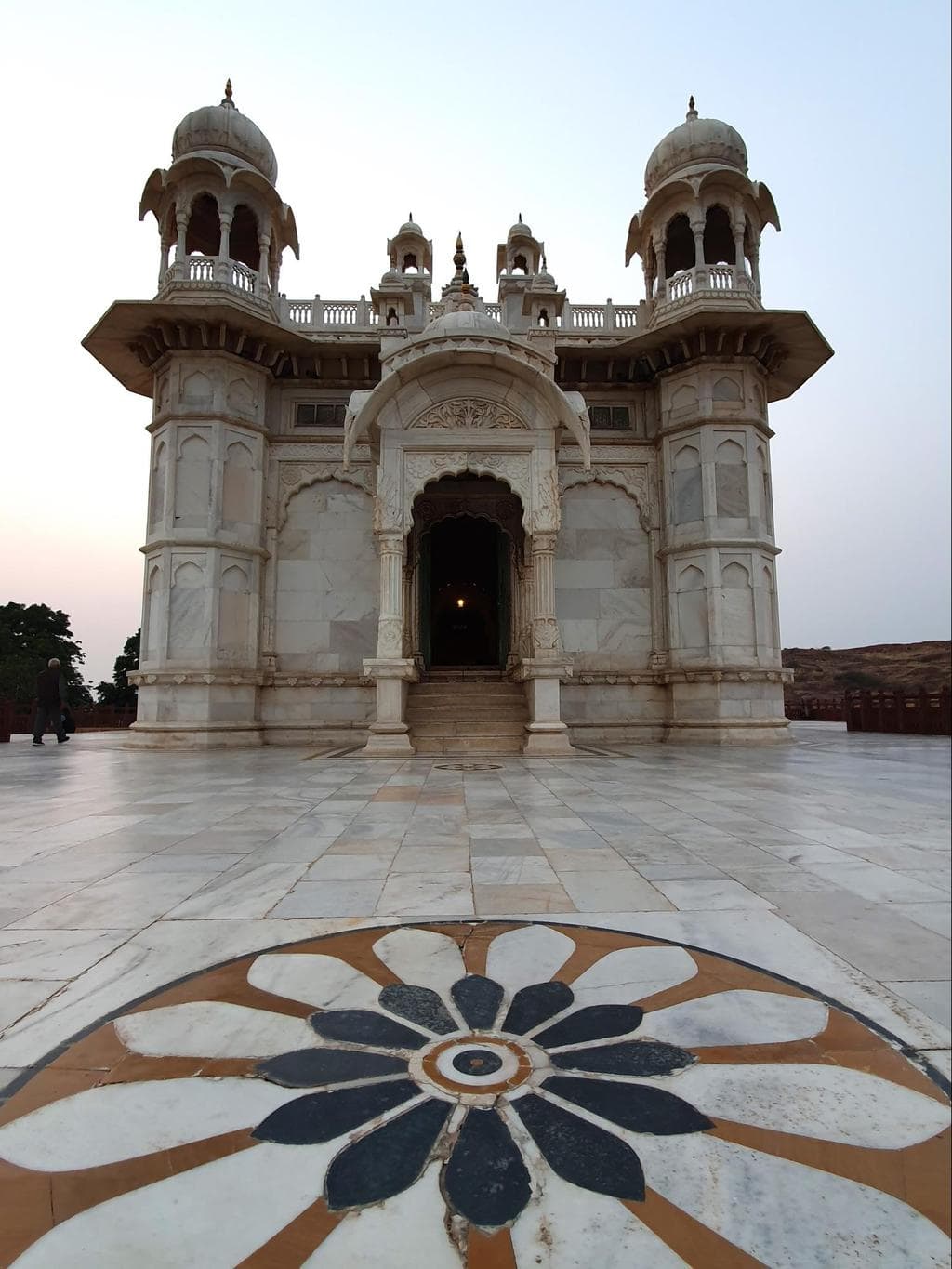
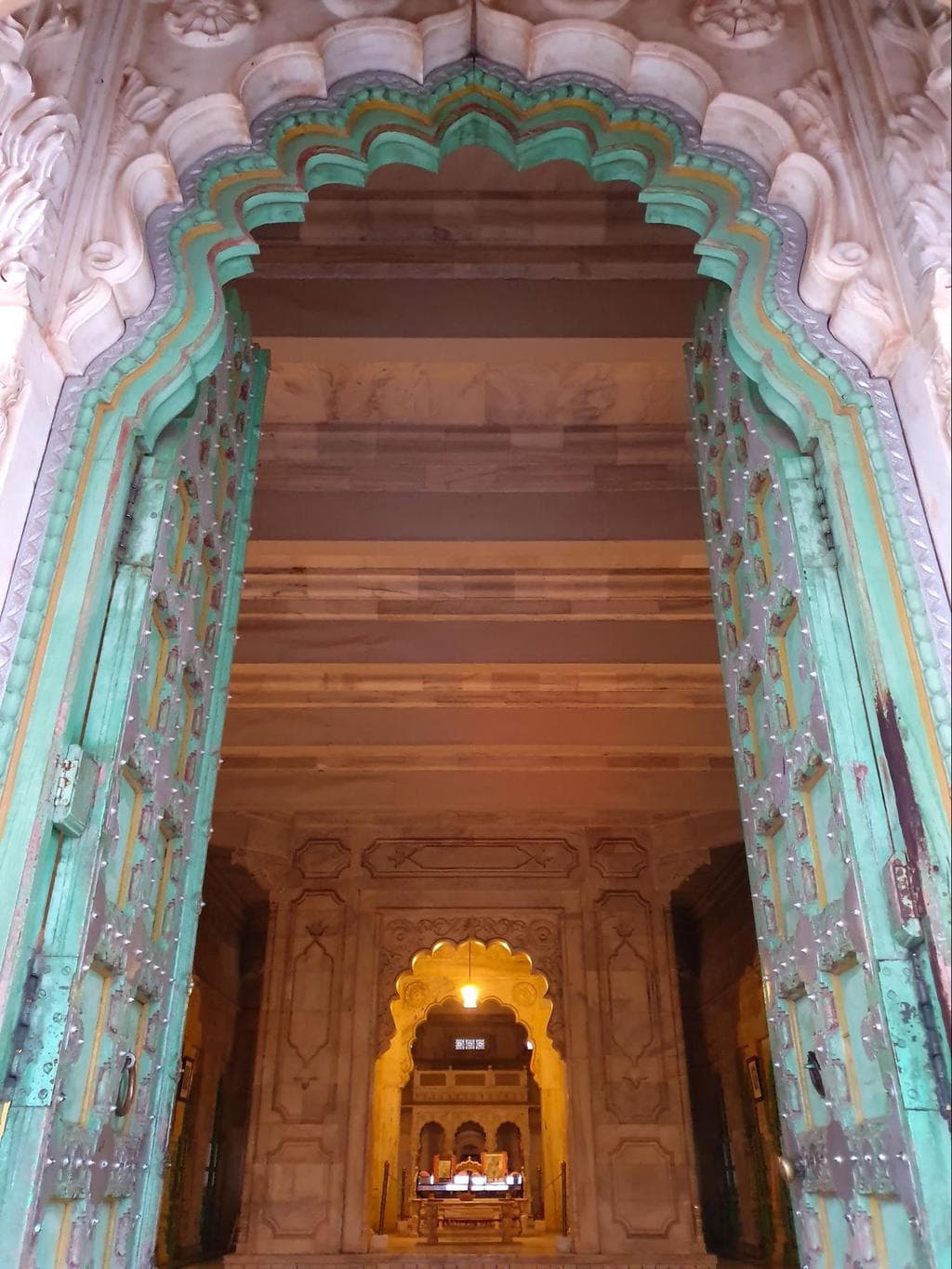
The complex also contains a temple and cremation grounds for the royal family. Inside the temple are paintings of the royal family hanging from the walls. There are lots of other smaller cenotaphs around it on the hillside.
Make sure to admire the city walls, which are 10km long and perfectly visible from the memorial. You can also see parts of it from the fort.
You can take a rickshaw from town to visit the memorial. Entry tickets cost 50 rupees, you will have to take your shoes off to get inside the temple.
If you prefer to go on a guided tour that also includes the rest of Jodhpur’s main things to do, here is the list of recommended tours from GetYourGuide.
- For the convenience of an all-inclusive experience, book a private tour of Jodhpur with a guide, all entry tickets and lunch. This tour includes the fort, Jaswant Thada, the Clock tower and Mandore Gardens. Book it here.
- Private tour of Jodhpur including the fort, the memorial, Umaid Bhawan. This tour does not include a guide, food or entry tickets, just transportation. Book it here.
- Private day tour of Jodhpur including the fort, the memorial, Umaid Bhawan and then in the afternoon, the Bishnoi villages. The tour includes driver and guide but no lunch. Book it here.
- Private tour of Jodhpur including the fort, the memorial, Umaid Bhawan followed by a desert camel safari in the evening. This tour does not include a guide, food or entry tickets, just transportation. Book it here.
Rao Jodha Desert Rock Park
Named after the founder of Jodhpur, this desert rock park is located right by the entrance to Jaswant Thada. The park recovered a large expanse of land that had been overtaken by an invasive shrub and regrew native species found in the desert areas near Jodhpur.
The park is interesting because you can learn a bit more about the flora of the desert and how plants find techniques to survive in places where there is no water and even no soil. If you are going on a desert safari in Jodhpur or in Jaisalmer, you will see what these desert landscapes look like, but here you can learn more about their survival.
More information here.
You can buy tickets for 100 rupees from the entrance and hire a naturalist if you would like for 200 rupees. There is a cafe and bathrooms. Bring an umbrella or hat as it is gets really hot and there is practically no shade.
I would suggest you go earliest in the morning, the park opens at 7am in the summer and at 8am in winter and this is the best time to enjoy it. The rainy season is particularly interesting because of the unusual vegetation.
Rao Jodha Park closes before sunset at 6:30pm in the winter and at 5:30pm in the summer.
Photograph the streets of The Blue City
The Blue City is one of the most famous landmarks in Jodhpur although it is actually located outside and to the back of the fort and further away from the city center, about 20min by car.
This part of the city is painted in blue because it is occupied by members of the Brahmin cast who follow Shiva whose color is blue. It is also said that the blue paint keeps the mosquitoes away and you will notice that the walls both inside and outside are painted not just the facade.
You may also see that many houses are painted in other colors, the wooden gates are bright yellow and red, and sometimes pastel turquoise and pink are also used.
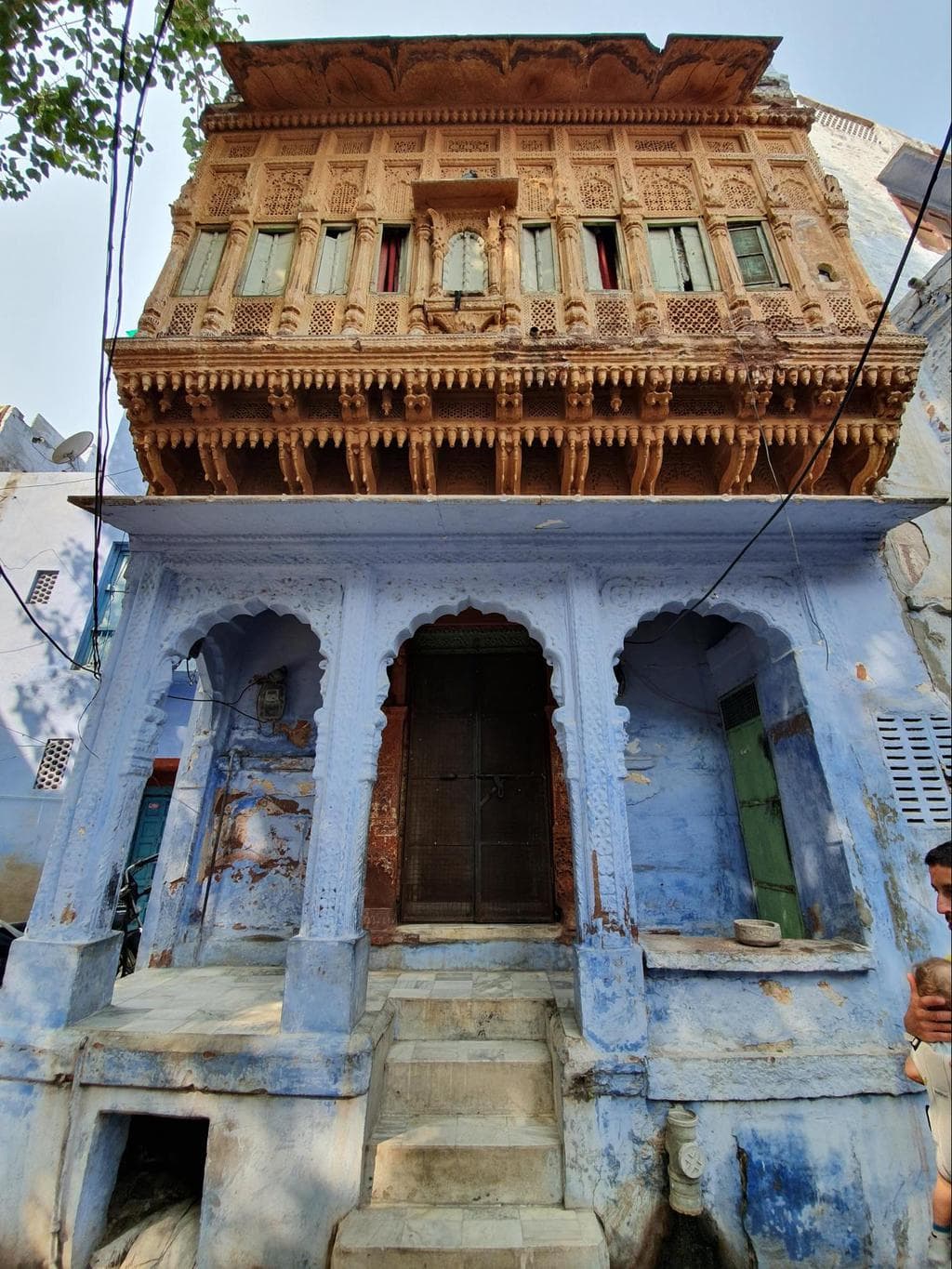
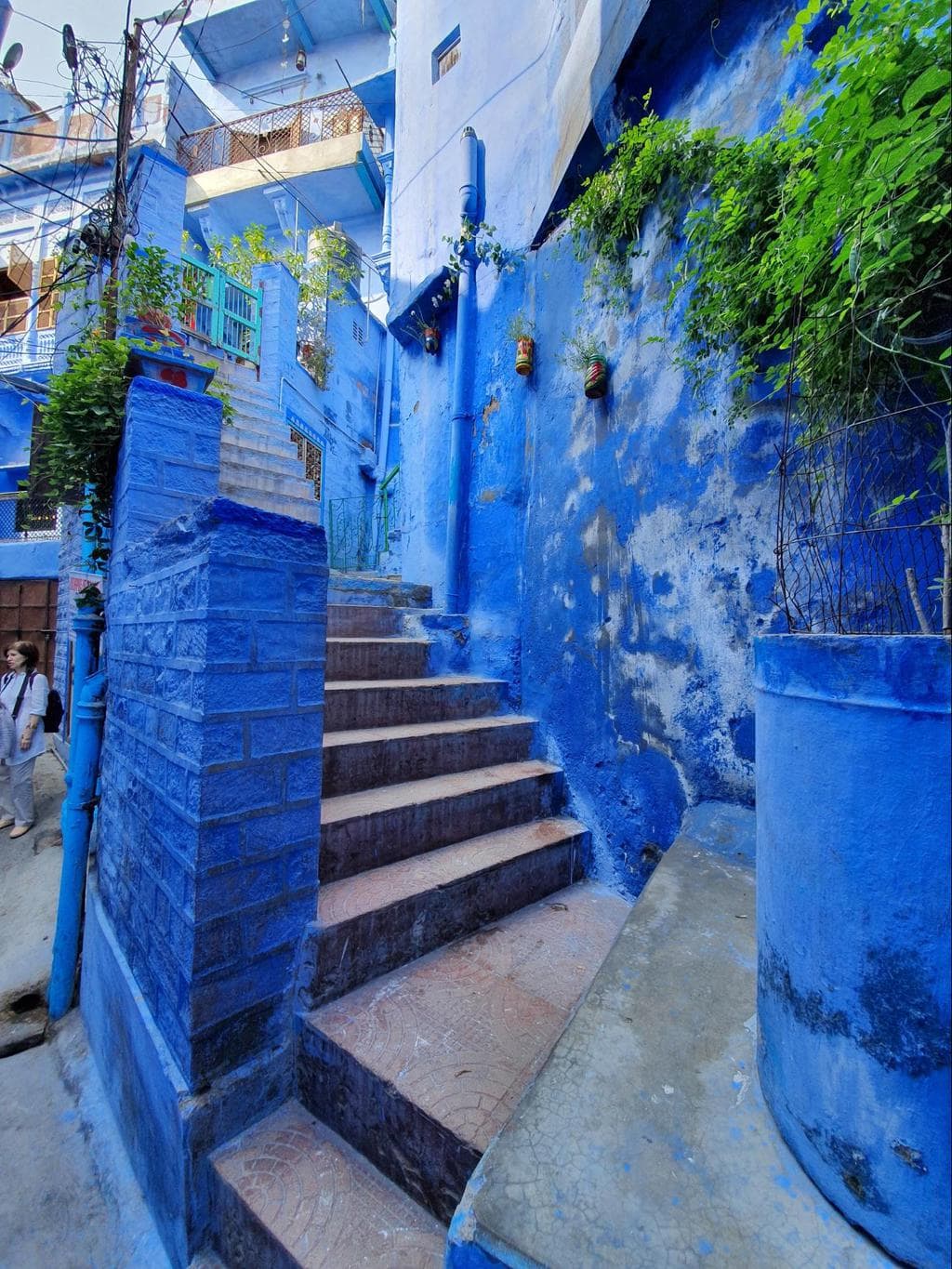
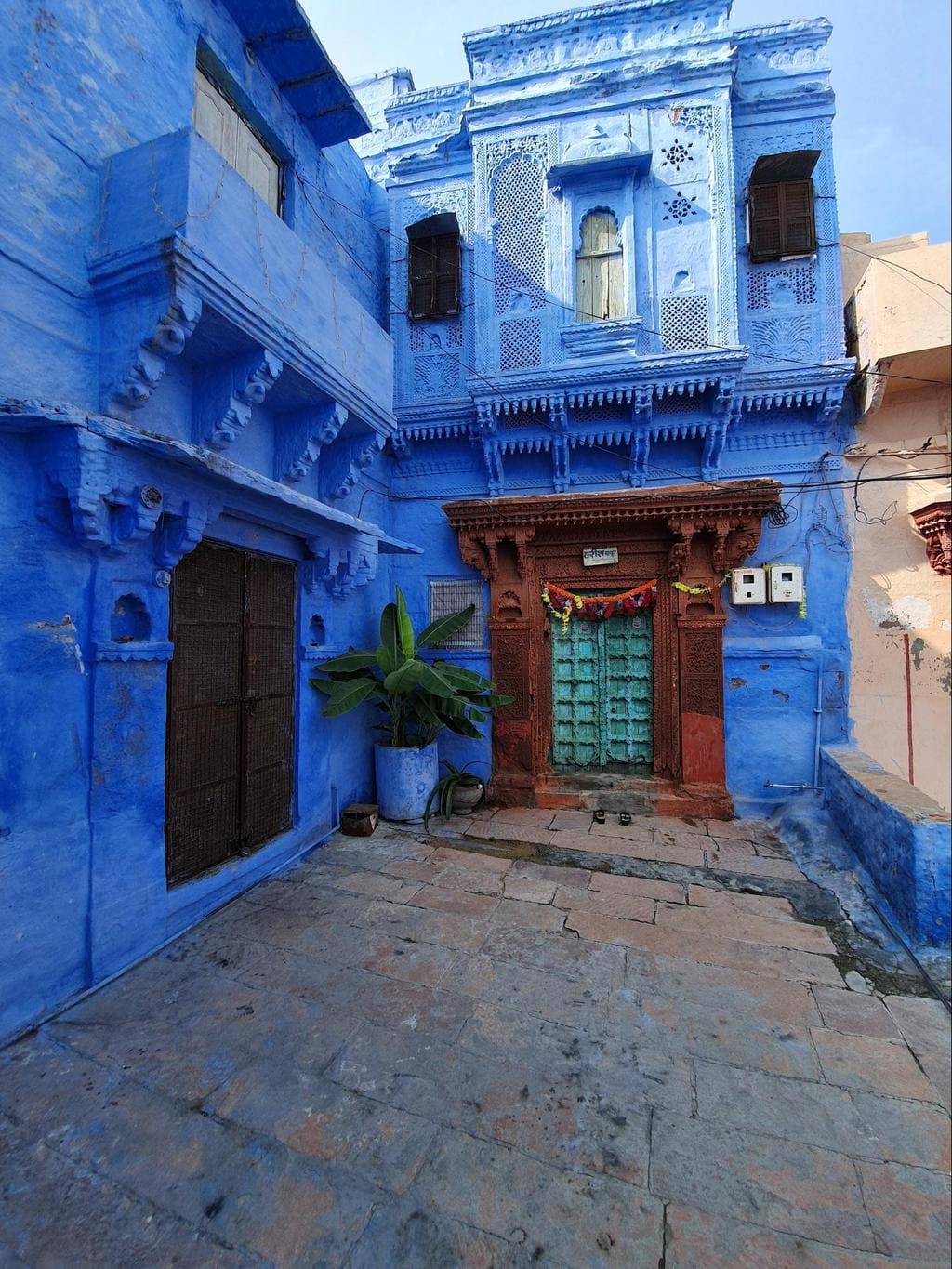
Photographing the Blue City is one of the best things to do in Jodhpur. The area is so photogenic and so colorful that it is every photographer’s dream. In addition, from some of the houses, you can have great fort views.
There is no entry ticket or anything here but it pays to get a guide because the alleys are narrow and the area a real maze. A guide can point to the best houses and the few temples and help you understand what you see. Do as I did and book a guided walking tour of the Blue City here.
Alternatively, just use Google maps to find your way back to a major street from where you can grab a rickshaw. I was in the area known as Chandpole, but I would really insist on getting a guide as not all streets are lined with blue walls and might be difficult to find on your own.
The best time to come is early in the morning when the city is waking up and there are no crowds. Even then, expect to find crazy scooters driving through and honking, a sound which echoes in the narrow lanes and amplifies.
Visit Umaid Bhawan Palace Museum
Umaid Bhawan is the world’s 6th largest private residence and India’s last palace to be built, before the country’s independence.
Everybody agrees that Umaid Bhawan is an impressive building that can even be seen from the fort, despite being several kilometers away. No visit to the city could be complete without going to see for yourself as this is one of the best things to do in Jodhpur.
The original palace is split into three parts: a museum that is open to the public, the private residence of the Maharaja and his family who still live here, and a luxury hotel that is managed by the Taj Hotel group and only accessible to guests or those who book a meal and tour.
The imposing residence was built as a means to employ the locals during a time of recession, famine and drought at the end of the 1920s. It employed 3,000 people for 15 years.
The construction was such an undertaking that a special train had to be built to bring the massive pieces of stone from a quarry several miles away.
The pieces first had to be dressed by a small army of stone artisan who were descendants of the workers who built Fatehpur Sikri and the Taj Mahal for the Mughals.
Umaid Bhawan’s construction started in 1929 and finished in 1943 making it a modern construction of Art Deco style designed by British Edwardian architect Lanchester and incorporating other influences.
The palace was built by the grandfather of the current Maharaja, Umaid Singh, but he lived there for a short period until his death. His son also died of a tragic plane accident and his grandson took over. All of their pictures are everywhere in the museum, hotel and palace.
Part of the palace was converted into a hotel in 1978, after Udaipur’s Lake Palace was turned into a luxury hotel and is managed by the Taj Hotel Group although the Maharaja lives in adjacent courts and is always around and known to welcome guests personally.
To say that Umaid Bhawan will leave you speechless does not even begin to explain what this pink palace looks like.
The building was made of the same palm court marble used for the Taj Mahal and has 347 rooms and a massive grand hall that can accommodate 300 people.
The museum has two main galleries, The Lifestyle Gallery that shows objects, furniture and daily life during the 40s and 50s, and The Legacy Continues gallery which showcases today’s royal family. You can even see the trophies won by the royal family at polo.
The furniture in the Palace was designed by Maples of London but the ship that carried the pieces sunk and local artisans in Jodhpur had to make replicas.
The Maharaja was a fan of Polish painter Norbin and had him decorate several rooms in the palace with monumental murals that take the entire wall including the Maharana and Maharaja suites. But the most impressive one is the Oriental Throne Room inside the museum.
The gigantic mural is dedicated to the love story in the epic Ramayana and depicts the fight between good and evil. The topic was befitting since the Rathore, the lineage Jodhpur’s royal family belongs to, are said to be direct descendants of Rama.
The murals are so important that the Polish Government has been involved in their restoration and preservation in the past.
Don’t miss a visit to the Maharaja’s car collection on display in a separate room by the garden. From here, you will also be able to photograph the palace in full.
The museum can be visited by buying a ticket at the entrance. Tickets cost 100 rupees. Look out for the peacocks that wander the property and are often seen by the ticket counter.
You can also book a tour of Jodhpur which includes a visit to the museum. Almost all tours of the city will stop here as it is one of the main sights of the city. Remember that if you book tours without a guide, you can still get one at the fort entrance and at Jaswant Thada. The museum exhibits have English signs.
Here are the best tour options:
- Private day tour of Jodhpur including the fort, the memorial, Umaid Bhawan and then in the afternoon, the Bishnoi villages. The tour includes driver and guide but no lunch. Book it here.
- Private tour of Jodhpur including the fort, the memorial, Umaid Bhawan followed by a desert camel safari in the evening. This tour does not include a guide, food or entry tickets, just transportation. Book it here.
- Private tour of Jodhpur including the fort, the memorial, Umaid Bhawan. This tour does not include a guide, food or entry tickets, just transportation. Book it here.
- If you are staying in Jodhpur for 2 days, I would recommend you book a private tour that combines half a day of sightseeing of Jodhpur (Fort, Jaswant Thada and Umaid Bawan) followed by a day out in the Bishnoi villages, a lunch break back at your hotel and an evening trip to Osian for the temples and the desert safari. Book it here. This tour is good value for money.
Splurge for dinner at Umaid Bhawan Palace hotel
The hotel was chosen by Priyanka Chopra and Nick Jonas for their wedding in 2018 and is a regular for celebrities and members of the wealthy Indian society. The only part that you can visit is the museum which has an entry fee.
If you are curious to see how the other half lives and want to take a peek at the Taj Umaid Bhawan palace, the best hotel in Jodhpur, you can do so by reaching out to them and requesting a tour of the hotel.
You will have to make a booking at one of the two restaurants for a meal which you can take before or after the tour.
Beware that the prices at Rajasthani Risala are steep, this was the most expensive meal I had in Rajasthan so it is only worth it for those that are hotel lovers and are looking for a splurge. I would highly recommend Pillars instead.
This outdoor and indoor casual eatery with views over the fort in the distance and the 12 column pavilion and gardens is the better option and the prices are more reasonable with international cuisine.
More information here.
This is not a regular activity available to tourists but if you email the hotel they will be glad to oblige. They told me the tour would end with a glass of champagne, but I never got that offered. The tour takes about half an hour and shows you the hotel main areas and, if a room is available, the rooms.
Visit a Bishnoi Village and have opium
The Bishnoi are followers of a Hindu sect in India that worships nature and animals to the extreme.
Their love for nature is such that in the 18th century, over 350 of them sacrificed their lives in what is known as the Kherjali Massacre to save the trees the Maharaja wanted to cut to build his palace.
When he found out, the Maharaja apologized and issued a decree forbidding trees being cut or animals being hunted within Bishnoi land which is still in effect today.
Bishnois live mostly in Rajasthan, in villages near Jodhpur, which is why day trips to see their ways of life are usually offered from here and make for one of the best things to do in Jodhpur.
Apart from protecting nature, the Bishnoi people are skilled crafters and avid weavers and will show you how they make carpets and other fabrics. You can also learn pottery and attend demonstrations of all kinds of handicrafts.
The products are usually available for purchase. Last time I visited we ended up buying a massive carpet that is still on the floor of my best friend’s house. Amid the arid landscapes and the mud houses, the weaver wiped out a credit card machine and we paid the carpet with Amex.
Unlikely anywhere else in India, the Bishnoi are allowed to drink opium as a ceremony that is part of their traditions. The opium pods used are empty and the opium is mixed with water and offered to guests to be drunk from the hands of the host.
To visit the Bishnoi villages you will need a driver and ideally, a guide. I have rounded up the best tours you can book from GetYourGuide below.
- Private day tour of Jodhpur including the fort, the memorial, Umaid Bhawan and then in the afternoon, the Bishnoi villages. The tour includes driver and guide but no lunch. Book it here.
- Private tour of the Bishnoi villages only. The tour lasts 4 hours and includes guide and driver. Book it here.
- If you are staying in Jodhpur for 2 days, I would recommend you book a private tour that combines half a day of sightseeing of Jodhpur (Fort, Jaswant Thada and Umaid Bawan) followed by a day out in the Bishnoi villages, a lunch break back at your hotel and an evening trip to Osian for the temples and the desert safari. Book it here. This tour is very good value for money.
Mandore Gardens
Mandore was the former capital of the region before the foundation of Jodhpur. What remains today is a series of gardens, temples, cenotaphs, the ruins of the former fort and beautiful gardens all of which make for a great half-day trip from Jodhpur.
Mandore Gardens are a pleasant visit because of the unusual greenery not really found in Jodhpur. The temples are very intricate and you should look out for the cenotaph built in memory of Maharaja Ajit Singh.
There does not seem to be an entry ticket to Mandore gardens and the site is open all day long but things change.
When to visit Jodhpur
As with most parts of India, it pays to plan well and in order to cover all the things to do in Jodhpur mentioned above, you will need to come in the right season.
The best time to visit Jodhpur is in the cool and dry season from October to March. However, I would also avoid October and November when the pollution from slash and burn agriculture in the region fills the air with haze and the days are not clear.
In my opinion, the best time to visit Jodhpur is therefore from January to March. December is a good month but towards the second half, the city fills with local tourists who come during their year-end vacation.
After March, temperatures increase significantly and days can see the thermometer easily climb above 40 degrees Celsius and after June the Monsoon season arrives and floods the streets.
Where to stay in Jodhpur
There are a few amazing hotels in and around Jodhpur that make for a beautiful location to base yourself. I have written an entire article about the best hotels in Jodhpur but below is a selection and summary.
- Umaid Bawan spells splurge like no other hotel and it is one of the most lavish there is in the entire country. The former and current residence of the Maharaja is a Taj Hotel and will take you back to the glory years of the Rajput kings. Check rates on Booking.com | Check rates on Agoda
- RAAS Jodhpur is located in the walled city and is a fantastic modern hotel with a chic and sleek design that is built in and around an old haveli. The pool is fabulous, as are the views. Get a room in the haveli for pure indulgence. Service here is excellent as is the food. Check rates on Booking.com | Check rates on Agoda
- Also in the walled city is Pal Haveli, a boutique hotel housed in an old haveli that has preserved the colorfully intricate designs, the stained glass and the Belgian mirrors to create the feeling of royalty. Check rates on Booking.com | Check rates on Agoda
How long to stay in Jodhpur
There are enough things to do in Jodhpur to keep you entertained for three days but two should be a good amount of time for a highlights trip. If you have longer, then make sure to visit the parts that are further away, the Bishnoi villages, the desert and Mandore Gardens.
How to get to Jodhpur
Unlike Jaipur, there are no international flights to Jodhpur and the city is not connected by air to other Rajasthani cities either. The airport in Jodhpur is a military base and civilian airport.
However, there is limited domestic air traffic. You can fly from Bangalore, Ahmedabad, Delhi or Mumbai or drive from Jaisalmer (5h) or from Udaipur (5-6h).
You can also visit Jodhpur onboard one of the luxury trains in India that cover Rajasthan, this is how I first visited the city, onboard the Maharaja’s Express.
What to pack for Jodhpur
Jodhpur is a semi-desert city and, as such, requires proper packing. Although you will find most of the below for sale across the touristy areas of every Indian city (this goes to show how important these items are) it pays to bring the brand that works for you.
Here are a few of the things you should bring to Jodhpur.
- Sunglasses, you will not go very far without them. Remember that the sun is very strong in India in general but here even more because the rays reflect on the sand. Also, the wind can pick up a lot of dust which will end up in your eyes. Bring a pair of trusty and safe sunglasses. I always use Oakley (I have for decades, literally since I was 16) and they are a lifesaver. They are not stylish or fancy, but they are incredibly useful to protect from the sun and from the sand. I have used this exact polarised model for years.
- A hat to protect from the sun. Except for the narrow streets which are shaded by the buildings, you will be under the sun everywhere you go so a hat is essential.
- Mosquito repellent, even at the fancy hotels, mosquitoes will find their way in. I always use either the brand Off! or Repel. They just work and are sold in small bottles that you can easily carry around.
- Sunscreen, like sunglasses and hats, sunscreen is a critical items when traveling anywhere that is hot and sunny. In Jodphur more than anywhere, you need to protect your face and arms from the sun with adequate sunscreen, and reapply. I always use Biore because it is dry, non-oily and I can even apply make-up on top of it. It comes in handy small bottles that can easily slip in my handbag and go through passport controls.
- I would recommend wearing closed shoes in Jodphur (everywhere in India really), to protect them from the sun, the mosquitoes, the dust, the dirt and the cow poo that covers the streets. I always wear flats like these ones because I find trainers too clunky.
- Ear plugs, many high-end hotels will give them to you, placing them on the bedside table, but it is a good idea to bring your own. Simple ones usually do, or you can get a more high-tech version.
This would make a great addition to your India Travel Pinterest board!
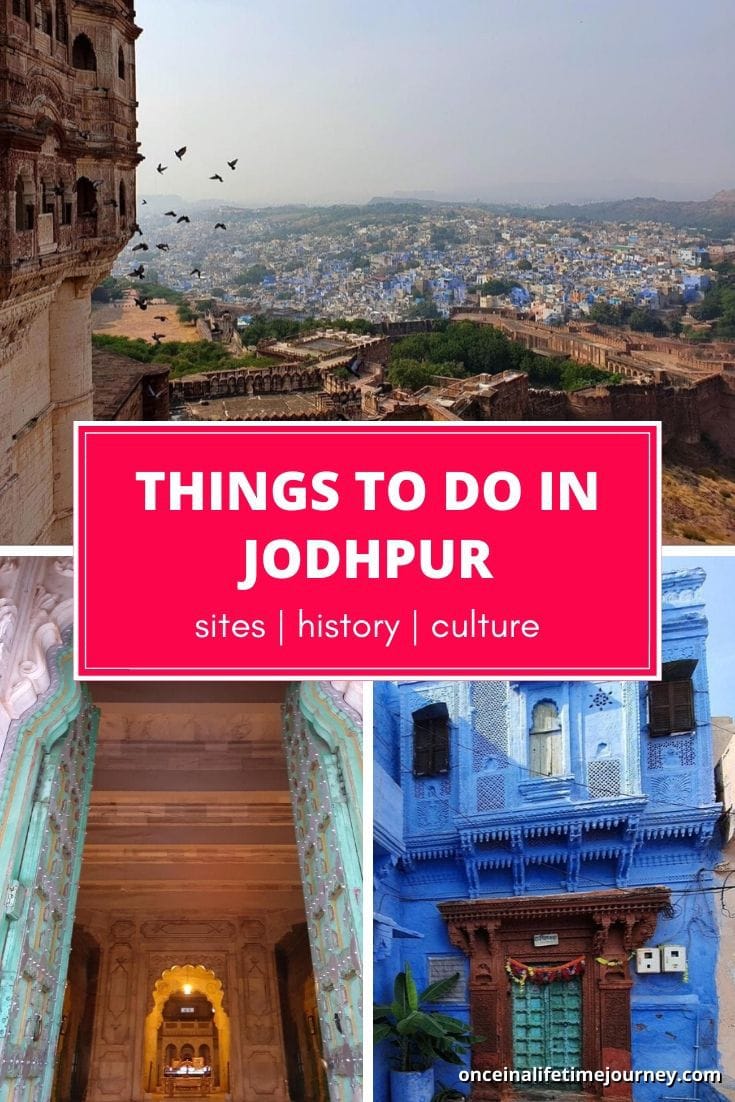
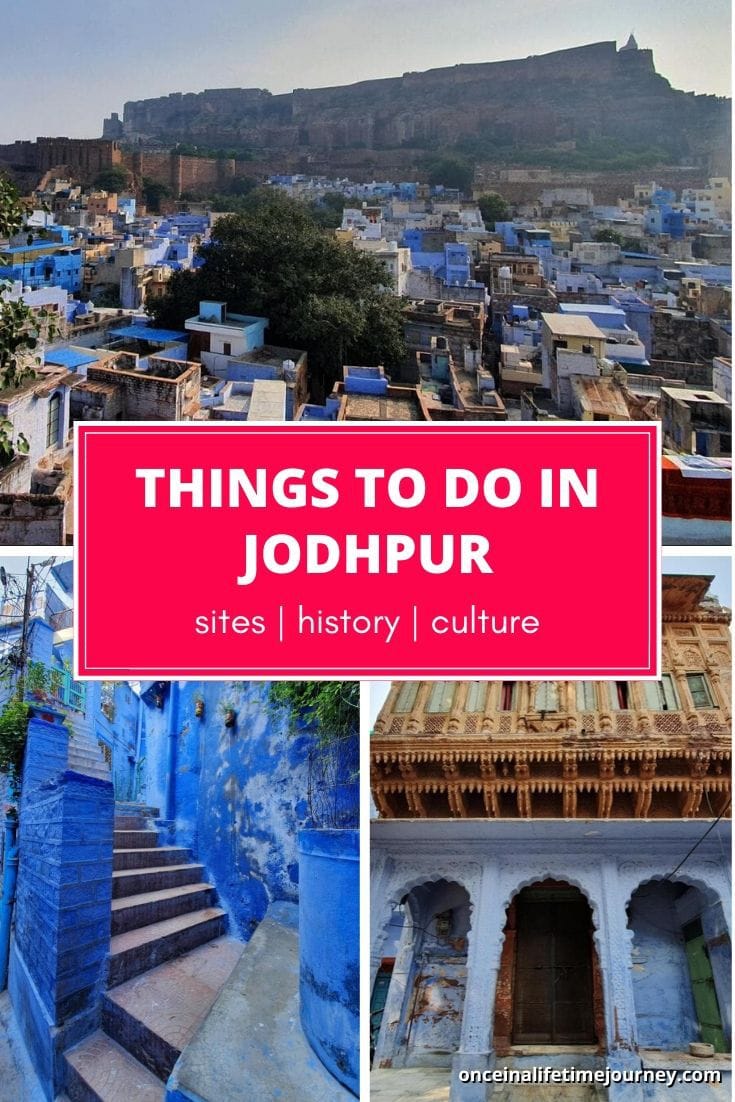
- Check if you need a visa, get help processing it at iVisa.
- Never ever leave without travel insurance. Get affordable coverage from World Nomads or long term insurance from Safety Wing.
- I find all of my flights on KAYAK. Check their Deals section too.
- Search for all your transportation between destinations on the trusted travel booking platform Bookaway.
- I book all my day trips and tours via GetYourGuide, they are the best and their tours are refundable up to 24h in advance.
- Get USD35 off your first booking with Airbnb.
- Compare hotels EVERYWHERE at HotelsCombined and book with Booking.com.
- Compare car rental prices at Rentalcars.com

